

Professional BoatBuilder Magazine
Delphine ii, the last big steam-powered yacht.
By Gérald Guétat , Sep 1, 2016

Original blueprint of the SS Delphine II .
At the origins of the Dodge industrial empire were two inseparable brothers, Horace and John, natives of a small Michigan town. The family was poor and the Dodge boys went to school barefooted. John preferred to look after horses, while his younger brother admired the passing boats on the nearby river. They had a younger sister, named Delphine. Horace loved above all to tinker, to invent small machines, and to play the piano, and his brother never seemed to raise his nose from reading books. At the turn of the 1900s, the Dodge brothers opened a little bicycle factory before operating a machine tool workshop. Horace had a genius for assembling high-precision parts. Soon, growing firms like Oldsmobile and Cadillac could not do without their subcontractor, the Dodge Brothers Company. Henry Ford also needed their services to manufacture some essential components for his first cars. As money to pay his bills was short, Ford offered to pay the two brothers in shares of his company. The Dodges’ fortune was made.
Horace Dodge could give free rein to his childhood love of boats. In 1903, when he was 35 years old, he bought his first 40 ‘ (12.2m) launch. The long, slender hulls of those touring launches were powered by steam engines designed and built by their owner. In 1910, he commissioned architect Henry John Gielow to design the 183 ‘ (56m) Nokomis , the family’s first large cruising yacht, powered, not surprisingly, by two Dodge steam engines. Following the 243 ‘ (74m) Nokomis II , in 1918, the automaker had Gielow design an even more prestigious yacht. The Great Lakes Engineering Works of River Rouge, Michigan, was in charge of constructing the largest steam yacht ever built in the U.S. Its length had to be limited to 262 ‘ (80m) to fit the locks of the Welland Canal and the Saint Lawrence River.
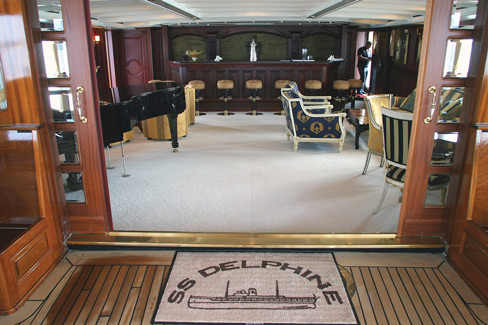
The main stateroom with piano and bar was restored, including the sliding windows with levers. On the bar is a thermos bottle in the shape of a coastal light, a gift from the Dodge family to Bruynooghe, recognizing Delphine II ’s renaissance.
This private ocean liner, built of 12mm-thick steel, was christened Delphine II in homage to Horace’s sister and to his young daughter. Onboard saloons, smoking rooms, a great staircase, apartments with fireplaces and bathrooms, all paneled with precious woods, could host about 18 guests and a crew of 52. Horace Dodge decided he would personally design the engineroom with two quadruple-expansion engines of 1,500 hp (1,125 kW) each. Horace Dodge died of pneumonia three months before the launching of his masterpiece. His brother John followed him a few weeks later, struck by the same illness. On April 2, 1921, Horace’s daughter swung the traditional bottle of champagne on Delphine II ’s hull.
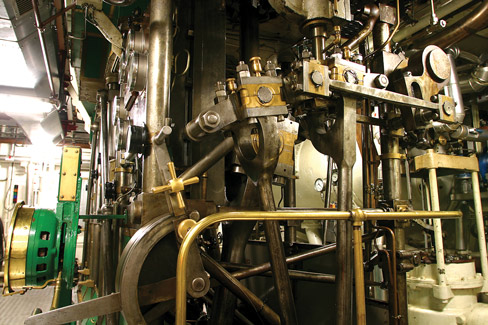
The two 1,500-hp (1,125-kW) quadruple-expansion steam engines were designed by Horace Dodge, who died just three months before the launching.
In 1925, Anna Dodge, Horace’s widow, and her sister-in-law made a fortune by selling their shares in the family business. Anna Dodge fitted the yacht for long-range cruising. The great steamer then voyaged around the Great Lakes and along the East Coast. During a stopover in New York, a fire sank the boat. The owner, who fortunately was not on board, had it raised and completely repaired by Brooklyn Shipyard.
Soon after the United States entered World War II, Anna Dodge received a requisition order from the U.S. Navy. In May 1942, the steam yacht was convoyed by a military crew from Detroit to Washington, where the Navy armed her with guns, painted her green and gray, and renamed her USS Dauntless . She was then assigned to the command of the chief of naval operations as the flagship of Admiral Ernest King. The USS Dauntless voyaged little during the war years but served as a residence and remote meeting place reserved for high-ranking officials. After the Japanese surrender, Delphine II was returned to her private owner, who refit her at great expense.

During World War II, the 262′ (80m) Delphine II was conscripted by the U.S. Navy, armed, painted camouflage colors, and renamed USS Dauntless .

Even Jacques Bruynooghe’s impeccable restoration wasn’t able to make the chartering enterprise a success.
But times had changed and steam yachts definitely belonged to a bygone era. The aging ship, no longer of interest to the family, was entrusted in 1968 to a merchant marine academy. In 1989, a Singapore-based company bought the old vessel and sent it from America to Asia with a long stopover in Malta. Next, a French business group moved her to Marseille, where she was later abandoned. In 1997, Jacques Bruynooghe, a Belgian textile industrialist, came to the rescue, planning a huge restoration project and a charter business. The restoration took about six years. The steam engines underwent a fascinating reconstruction.
In 2003, Delphine II was relaunched as the last and only large steam yacht in the world, but Bruynooghe’s charter business was not successful. He put her up for sale in 2004 for € 46 million, reduced 12 years later to € 16 million. Today, this rare witness to a glorious era lies in Monaco awaiting a new owner. It’s listed for € 19.75 million on www.jamesedition.fr.
[A longer version of this article was published in Classic Superyacht magazine in January 2012 . ]
Read more Rovings articles

- Departures: Carl Chamberlin
Passionate, competent, considerate, modest, and thoughtful is how designer and boatbuilder Carl Chamberlin is remembered by those who knew him. He died last November at age of 75 in Port… Read more »

- SAFE Boats Regains Small-Business Status with Employee Ownership
More than 20 years ago, Professional BoatBuilder ran a feature titled “God, Country and Fast Boats” (No. 85, page 64) about SAFE Boats International (SBI), a Bremerton, Washington–based manufacturer of aluminum boats…. Read more »

- SNAME Powerboat Symposium Is Back
The Society of Naval Architects and Marine Engineers (SNAME) Technical and Research Program, in cooperation with the Hampton Roads, Virginia Section of SNAME, will host the Sixth Annual Powerboat Symposium… Read more »

Recent Posts
- Find out how 3D printing can help your boatbuilding with MASSIVIT
- Van der Werff’s Curved Wood
- Companies (85)
- Construction (106)
- Design (161)
- Drawing Board (10)
- Education (25)
- Environment (16)
- Events (21)
- Materials (50)
- Obituary (18)
- People/Profiles (49)
- Products (16)
- Propulsion Systems (32)
- Racing (16)
- Repair (37)
- Rovings (317)
- Short Cuts (3)
- Sponsored Partner News (14)
- Systems (80)
- Task Sheet (1)
- Uncategorized (26)
- Wood to Glass (7)
ProBoat.com Archives
The 101-year-old classic yacht that runs on steam

The SS Delphine is an iconic yacht that reached a major milestone in April 2021: celebrate its 100th birthday . Now, a year older, the yacht has been renovated on the inside but still uses steam to move around.
“She is the only superyacht in the world still operating today with her quadruple expansion steam engines,” -Emmanuel R Buetss, SS Delphine’s Manager.
SS Delphine’s origins
Although it was built for Horace Dodge , American automobile manufacturer pioneer, the 78-metre yacht has hosted heads of states while they planned peace treaties . SS Delphine was launched in 1921 at Great Lakes Engineering Works . At that time, she had the largest gross tonnage of any yacht in America.
Originally it was equipped with Babcock & Wilcoz boilers. These supplied power for her two 1,500-horsepower steam engines. However, the engine room was updated in 2003 during a refit. Now, two modern water-tube boilers that power the original engines.
In 1926 the SS Delphine was almost destroyed after catching fire and sinking in New York. However, she was miraculously salvaged and restored.
Christened as the USS Dauntless
In 1942 SS Delphine was requisitioned by the US Navy and christened the USS Dauntless. During this time, she served as the flagship for naval commander Admiral Ernest King during WWII.
Once the war was over, she hosted US president Franklin D Roosevelt, vice president Harry S Truman, UK prime minister Winston Churchill and Russian diplomat Vyacheslav Molotov . This was when they prepared for the Yalta Conference, the event that determined how Europe would be reorganised after the war.
“The privileged status of having been Admiral Ernest King’s ship certainly helped her avoid the unfortunate fate of other steamships that did not survive the war, allowing her to delight us today with her original splendor.” -Buetss
Times of changes
Once WWII was over, she returned to the Dodge family. However, over the next 50 years she changed of owners on several occasions. As a result, by 1997 her condition had worsened, so although the owner paid a low price for the vessel he had to pay €45 million to restore the iconic yacht to its former glory.
During the five-year restoration, her original Tiffany décor layout and design was kept as possible.
“That is indeed why sailing on board the SS Delphine is not only a maritime journey, but above all a journey through time that takes us back to the Belle Époque of the 1920s in the decorations, carvings, wall patterns and carpets that are exact replicas of the 1921 plans,” -Buetss
Current times
In 2003 the yacht changed names once again, this time by HSH Princess Stephanie de Monaco. Now, the current owners offer exclusive events aboard the yacht and charters in the Mediterranean.
You might find interesting: How expensive is it to charter a luxury yacht?
“Sailing on SS Delphine is not only a visual pleasure but also the opportunity to enjoy a steam engine which, beyond its timeless aesthetics, also offers a unique noiseless and vibration-free comfort forgotten by the hectic modern machines,” -Buetss
The SS Delphine can receive up to 26 guests to sleep onboard and up to 150 guests for day events . Moreover, she is now equipped with modern comforts expected from a charter yacht: she has a sauna, jacuzzi, hammam, gym, swimming pool and a dressing room. This together with her Tiffany décor in her dining rooms, lounges and suites make her a unique vessel.

WE AND OUR PARTNERS USE COOKIES ON THIS SITE TO IMPROVE OUR SERVICE, PERFORM ANALYTICS, PERSONALIZE ADVERTISING, MEASURE ADVERTISING PERFORMANCE, AND REMEMBER WEBSITE PREFERENCES. BY USING THE SITE, YOU CONSENT TO THESE COOKIES. FOR MORE INFORMATION ON COOKIES INCLUDING HOW TO MANAGE YOUR CONSENT VISIT OUR COOKIE POLICY .

ULTIMATE RESTORATIONS: Cangarda: The Last American Steam Yacht (Series Premiere)

Airs Monday, February 16, 2015 at 10 p.m. on KPBS TV
KQED presents a new eight-part series, ULTIMATE RESTORATIONS , featuring the spellbinding restorations of irreplaceable masterpieces. ULTIMATE RESTORATIONS showcases the rescue and restoration of some of the most valuable mechanical icons of the Golden Age (1880-1940), a high point in innovation and craftsmanship. The series, hosted by Bob McNeil, tells the spellbinding stories behind eight of American history’s greatest historical and engineering treasures — the world’s largest pipe organ ; a surviving 1920s fire engine ; a “fish car” designed to transport live fish by train ; a priceless carouse l; a World War II spy plane ; one of the first U.S. yachts to round Cape Horn and a famous steam locomotive . The passionate restorers and committed craftspeople discuss the challenges associated with reviving these massive icons to their original glory: moving huge pieces of equipment, salvaging from sea-floor beds, searching for rare parts, and dealing with complicated mechanical systems.

"Cangarda: The Last American Steam Yacht" - The last existing American stream yacht was nothing more than an eyesore stuck in the mud of the Boston harbor until Bob McNeil came to its rescue. His four-year restoration of the 136-foot vessel revives old construction techniques alongside new technologies with the help of the colorful crew of Rutherford’s Boat Shop in San Francisco. After 112 years and more than a few setbacks, the Cangarda finally sails again.
- International edition
- Australia edition
- Europe edition
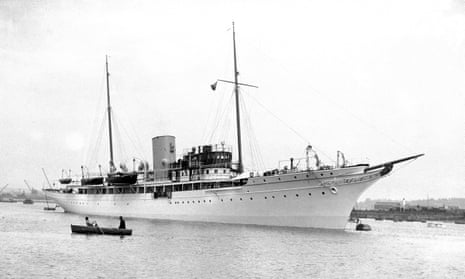
From Edward VIII to James Dyson: the yacht that tells a tale of British wealth

The fortunes of industry and a handful of ultra-rich individuals are woven through the history of the Nahlin
I n the early years of this century, soon after he began moving production of his bagless vacuum cleaner from Wiltshire to south-east Asia , James Dyson bought a superb yacht. The Nahlin is exemplary in the beauty of its lines and instructive in its history, though how much of this history Dyson understands or relishes is hard to know. Despite spending a fortune (at least £25m) on its restoration, Dyson has never talked publicly about his yacht, no more than he has about his purchase of Singapore’s most expensive flat (£43m) and its sale soon after, at a loss. For a time, a kind of omertà prevailed about the vessel’s ownership among its team of restorers, though to own and care for such an elegant piece of naval architecture would surely be no shame.
What Dyson certainly knows is that it was on the Nahlin that King Edward VIII and Mrs Wallis Simpson shed any discretion and “came out” as a couple – a relationship reported across the world, though not at the time in Britain – precipitating the crisis that ended with the king’s abdication a few months later, in December 1936. “The cruise of the Nahlin” became an inevitable chapter in any telling of the event, though how the king came to be aboard such a mysteriously named vessel tended to be overlooked. In fact, the name is said to have Native American origins, and reportedly means “fleet of foot” – the yacht’s figurehead wears a chieftain’s headdress – and the king was aboard because the Foreign Office, worried by social unrest in France, had warned against his original plan to rent a villa there.
So instead he rented the Nahlin, to avoid the fuss that a voyage in the royal yacht, the Victoria and Albert, would create and perhaps also because the Nahlin, commissioned only six years earlier, appealed to his appetite for cocktail modernity. Fuss, however, was unavoidable. At Šibenik, the Dalmatian port where the king and Mrs Simpson boarded the yacht, an exuberant crowd of 20,000 turned up and (thanks to reports in the American press) showed as much interest in her as in him; at sea, two Royal Navy destroyers, the Grafton and the Glowworm, accompanied the Nahlin wherever she went – a leisurely August progress down the Adriatic, through the Corinth canal to the Greek islands, and eventually to Istanbul. The “nanny-boats”, as Lady Diana Cooper called them; she and a few other prominent society figures were also aboard, as well as a crew around 60-strong.
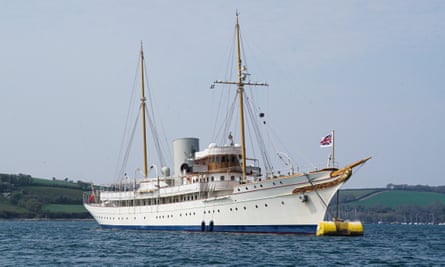
Of course, the term yacht is misleading. No sails have ever been involved. The Nahlin, like its bland modern equivalents, was a yacht only in the sense that its sole purpose was its owner’s pleasure, the owner being in this case a Lady Yule. Launched in 1930 from the Clydebank shipyard of John Brown & Co – builder of celebrated liners such as Cunard’s two Queens – it measures 300ft in length and was originally powered by four steam turbines. Characteristically of the steam yacht, of which the Nahlin was among the very last examples, its hull preserves elements of the sailing ship, with a curved clipper bow and a counter stern, each stretching well beyond the waterline. The shape and colour of steam yachts – white hull, cream funnel – made people think of swans. Their costs and months of idleness meant they were an indulgence that only the richest magnates on either side of the Atlantic could afford: JP Morgan, Cornelius Vanderbilt, Sir Thomas Lipton.
And Lady Yule? She was thought to be the richest widow in England. How had she come by her money? Jute, was the short answer. A longer one involves a story of British innovation and industrial expansion overseas that Dyson might recognise, beginning in the 1820s when Dundee manufacturers began to look for an alternative to hemp in the making of sacking, rope and sailcloth. Jute was cheap and reliably available from Bengal in British India, but it was tough and brittle and broke easily when it was spun or woven. After years of experiment, it was successfully made pliable by the application of whale oil, of which Dundee as a whaling port had no shortage.
The demand for jute fabric and jute rope boomed, and Dundee enjoyed a near monopoly until the 1870s, when British industrialists began to open jute mills in Bengal itself because, as economic historian Morris D Morris has pointed out, “jute manufacturing was not a complicated process [and] cheap labour was a very great advantage”. Bengal had five jute mills in 1870 and 69 jute mills in 1914, as cheaper Indian-made jute conquered foreign markets previously served by Dundee, and exports of jute cloth from India grew 272 times over the same period; even better was to come with the first world war, when the word “sandbag” must have sounded like a ringing cash register in the inner ear of every Indian jute trader.
The Yule family benefited enormously. Annie Henrietta (Lady) Yule was the daughter of Andrew Yule, the son of a small-town draper in Scotland who arrived in Kolkata (then Calcutta) in 1863 as an agent representing several British firms, and whose family eventually owned tea estates, coalmines, cotton and flour mills, railways, and 2,400 square miles of productive land – as well as the jute mills that Andrew Yule’s nephew and successor, Sir David Yule, had taken an especial interest in expanding. Sir David was a shy workaholic who rarely left Kolkata. Aged 42, he married another Yule, his cousin Annie Henrietta. When he died in 1928, soon after ordering his steam yacht, the Times described him as“one of the wealthiest men, if not the wealthiest man, in the country”.
Where did it all go? Lady Yule and her daughter Gladys made a long and expensive world cruise in the Nahlin in the early 1930s. She invested heavily and sometimes unwisely in the British film industry; she opened a stud farm. She had, in the words of the Oxford Dictionary of National Biography, “strong religious opinions, a sharp tongue, and imperious habits”. Her attempt to force teetotalism on the Nahlin’ s crew was probably not a success. At any rate she sold the ship to King Carol II of Romania in 1937, after which the Nahlin disappeared from the map of British interests – missing, presumed dead – until an English yacht broker, Nicholas Edmiston, discovered it moored in the Danube as a floating restaurant in the 1990s. It passed briefly through the ownership of another Brexit-supporting tycoon, Sir Anthony Bamford, before Dyson bought it in 2006.
This week, thanks to the wonder of digital ship location, I traced the yacht’s present whereabouts to the Blohm+Voss shipyard in Hamburg; it had reached there from the Caribbean via Gibraltar and Falmouth. Blohm+Voss spent millions of Dyson’s money when the yacht was first restored and re-engined, and it may be there now for its annual overhaul. The shipyard is old and distinguished, and still fills the harbour with the sounds of building and repair work. They even build luxury yachts there; the clients include Roman Abramovich and Vladimir Putin.
Nothing remains of the Nahlin’s birthplace at Clydebank, apart from a large crane that stands useless at the river’s edge. Ships, like bagless vacuum cleaners and jute, are made elsewhere.
Ian Jack is a Guardian columnist
- James Dyson
- Shipping industry
Most viewed

Wilkins 42 ft Steam Schooner 1893 - Sold
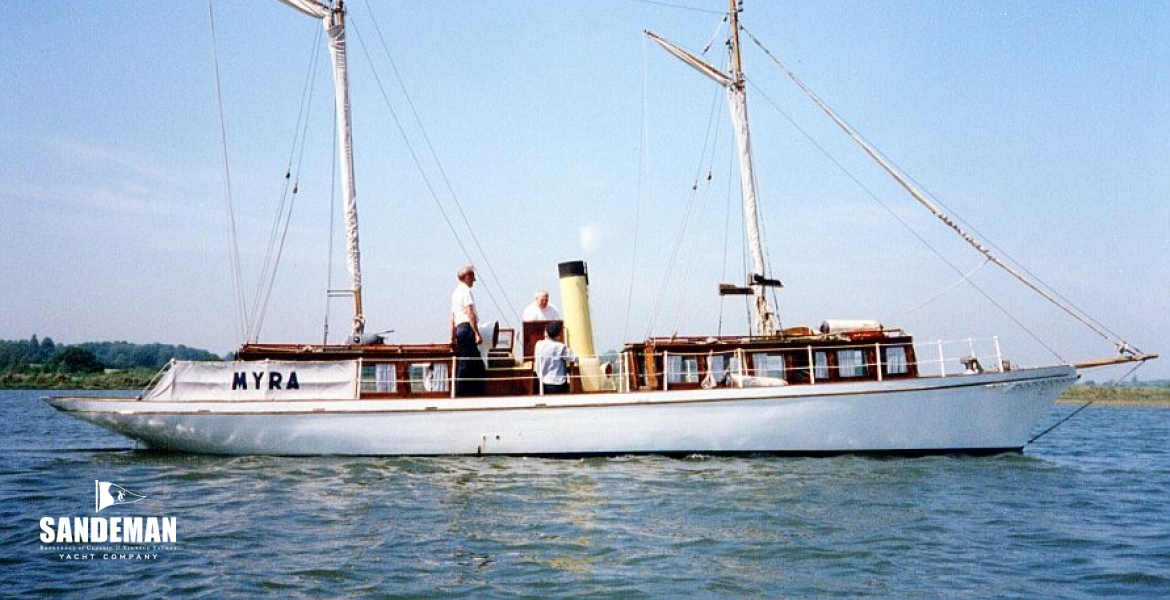
Wilkins 42 ft Steam Schooner 1893
These details are provisional and may be amended
BROKER'S COMMENTS
MYRA is about as elegant as any yacht can be; built of teak bronze and iron in 1893. She is an extremely exciting project with many of her original fittings and details intact but this should not be undertaken lightly because of the extent of the work needed. We believe MYRA to be totally unique and therefore her next owner will be rewarded by a vessel that surely defines the oft over used term “Gentleman’s Motor Yacht”.
Restoration project
This vessel is offered for sale as a restoration project and some of the pictures used are historical and do not necessarily show the vessel as she is today.
Built in 1893 for wealthy young man and serial steam yacht owner Willie Mackenzie of Colchester by J A Houston of Rowhedge; MYRA is a steam schooner, carvel built of teak and gaff rigged. The original steam compound engine was built by Mumford of Colchester, one of the world\'s largest steam engine builders of the late 19th Century. This remarkable vessel was used by Mr Mackenzie in a variety of roles both as a vessel for day trips out with friends and admirers such pleasures much enjoyed in those days as well with accommodation for 4 and a sea going capability; more extended voyages. Her second owner, one WJP Peacock used her from 1896 to the outbreak of war in 1914 for watching yacht racing and again for day sailing and longer trips - functions she could perform again in great style. Another story has it that she went over to Paris – to win 1st prize in the maritime section of the Great Exhibition of 1903, later plying the Seine on day trips but this is uncorroborated. Her subsequent owners from 1920 were: R S Heard of Swansea and J Hughes Rice of Newton, Glamorgan, who owned her until at least 1932. Details of her history thereafter are scant. Between the wars Myra had been fitted with a petrol engine but kept her schooner rig. After WWII she declined through neglect – left it seems for many years in Ipswich dock sans engine. It was there, by then in the 1970s that Peter Darby owner of Everson’s boatyard at Woodbridge found and after long negotiation, bought her. Once agreed he had her moved quickly by road to his own yard, where close inspection revealed that in spite of long immersion in brackish waters the hull condition was exceptionally good, requiring only limited re planking but total re caulking. Substantial refitting included removal of the petrol engine and concrete ballast as well as treating and replacement thereof. The deck caulking was completely stripped out and finding the timbers good, they were treated and re caulked. The interior was scraped back to bare wood, re varnished and deck houses re glazed. The original steam engine long gone, all sorts of options for an engine were considered, given Peter Darby her owner was a builder of steam engines himself. Looking for something suitable he found an awesome triple expansion engine, commercially built to deep sea standards; possibly a college training engine, which fine engine he bought and fitted – with remarkable ease as it happens. To power it initially he created a new oil fired 3 drum water tube boiler but replaced this later with a return tube boiler of Scotch design. It is worth noting that the combined size of this boiler and engine required some repositioning of the propulsion system further forward in the vessel, with some consequent re positioning of cabin spaces. MYRA made her second “maiden” voyage – the first time she’d steamed since 1920 on 18th December 1979. She was subsequently refitted with her schooner rig and is believed to have steamed regularly up to around 2005. pictures exist of her sailing hard pressed - and her surprising performance confirmed by her previous owner. More recently she was acquired by the Schiffs und Yachtwerft Dresden where further work was carried out and then acquired by her current owners in 2012.
Construction and condition
The teak carvel topside teak planking is considered to be 95% excellent and two large sections have been stripped to show the beautiful colour and patina of the 120 year old teak. Below the waterline again the teak planking is mostly good, but the garboards – believed to be of elm need attention. Fastenings are copper and bronze. The deck is not so good and the 1½ inch pine, swept deck planking - possibly the original, will need to be replaced. Both deck houses are complete and sound but require full cosmetic refurbishment. Cabin tops are teak (laid fore/aft) doubled with diagonal teak beneath. The grown oak frames and steam bent oak timbers do need significant work with about half needing repair, doubling or replacement. The keel is straight and well supported on a 40 ft flatbed trailer.
Rig spars and sails
- Schooner rig with loose footed sails and furling by brailing - The masts need work or replacing but have all the fittings. - The gaffs are varnished and look good - Galvanized rigging and all blocks are present but need attention - Main sail sheet track well aft on the counter - Foresail tacks with a Lazy sheet - Wickham Martin type Jib furling - The sails are scruffy but will provide good patterns
Deck fittings
- All deck fittings for sailing except ship\'s wheel are present - Additional fittings include the bronze coaling hatches, period anchor winch and capstan - Forged iron tiller enabling steering from the counter - Bronze chain plates - Ship\'s bell is in Rostock NE Germany and attempts are being made to repatriate
Engine, mechanical and electrical
- Triple expansion steam main engine - no maker’s plate apparent but probably by Sissons - Cylinders of 4.5 inch + 7 inch + 10 inch x 6 inch stroke - Engine is complete and has crosshead driven air pump for the condenser - Eccentric driven boiler feed pump and chain drive to a 12 volt generator - Remote control Stephenson reverse gear and regulator enables deck or engine room control - Engine complete but now not free so needs stripping cleaning and reassembly - Dry backed Scotch type Boiler, currently oil fired - Domestic type burner converted to 12 V - Steam donkey engine with own condenser and salt water pump powers a second generator - Generator for battery charging or lighting when main engine is stopped - 2 x Modern fuel tanks for paraffin or 28 sec heating oil are currently removed for access - 2 x Top up water tanks and the hot well water tank for boiler feed water - Water can also be fed by injector - Boiler certificate expired and the boiler will require attention or replacement - All fittings, gauges etc are available
Interior from forward
- Chain locker, with some storage, very pretty teak oval hatch - Head with period Downton pattern WC and bronze pumps currently discharging over side - J Stone fold away self draining basin with nickel plated taps, pump and all parts - Ladies fore cabin panelled in dark oak; 2 x berths, needs a full cosmetic restoration - Table with drop sides, fiddles and bottle storage - Engine room containing the propulsion and generating etc equipment - This space was originally just the boiler room - Aft cabin; 2 x berth and galley mostly teak interior of 1970 s vintage currently stripped out for access - All parts labelled for replacement if wanted - This cabin was originally the engine space plus crew quarters - Also in store; an early Simpson Lawrence stove and a classic pattern Patay galley pump - The Windermere kettle is in Rostock NE Germany - attempts are being made to repatriate - Lazarette mostly dedicated to the large diameter steering quadrant but with some storage
Owners notes and comments
MYRA is complete but needs new decks and a substantial restoration The original Mumford compound engine - or one identical from near MYRA’s home port is currently for sale at Preston Steam Services Ltd near Canterbury in the UK. If a potential purchaser would wish to fit a different steam or maybe diesel engine the owners would be willing to sell her without the existing machinery, which could be removed with ease having been installed only to facilitate the move from Dresden back to the UK. MYRA is currently on a 40 ft York artic trailer with air suspension, which is also available for sale by negotiation. She could very easily be delivered anywhere with road access; including USA as there are RoRo services to most parts of the world. Height with funnel etc removed is under 4 m. Assistance could be given to the new owner with moving if required. MYRA is listed as a project boat in need of restoration but once completed she would be a unique vessel and the belle of the ball at any regatta or gathering.
These particulars have been prepared from information provided by the vendors and are intended as a general guide. The purchaser should confirm details of concern to them by survey or engineers inspection. The purchaser should also ensure that the purchase contract properly reflects their concerns and specifies details on which they wish to rely.
Sandeman Yacht Company
Brokerage of classic & vintage yachts.

The global authority in superyachting
- NEWSLETTERS
- Yachts Home
- The Superyacht Directory
- Yacht Reports
- Brokerage News
- The largest yachts in the world
- The Register
- Yacht Advice
- Yacht Design
- 12m to 24m yachts
- Monaco Yacht Show
- Builder Directory
- Designer Directory
- Interior Design Directory
- Naval Architect Directory
- Yachts for sale home
- Motor yachts
- Sailing yachts
- Explorer yachts
- Classic yachts
- Sale Broker Directory
- Charter Home
- Yachts for Charter
- Charter Destinations
- Charter Broker Directory
- Destinations Home
- Mediterranean
- South Pacific
- Rest of the World
- Boat Life Home
- Owners' Experiences
- Interiors Suppliers
- Owners' Club
- Captains' Club
- BOAT Showcase
- Boat Presents
- Events Home
- World Superyacht Awards
- Superyacht Design Festival
- Design and Innovation Awards
- Young Designer of the Year Award
- Artistry and Craft Awards
- Explorer Yachts Summit
- Ocean Talks
- The Ocean Awards
- BOAT Connect
- Between the bays
- Golf Invitational
- Boat Pro Home
- Global Order Book
- Superyacht Insight
- Premium Content
- Product Features
- Testimonials
- Pricing Plan
- Tenders & Equipment
Historic steam superyacht SS Delphine for sale at Northrop & Johnson
SS Delphine is the largest steam ship ever built in the United States. She was ordered by Horace Dodge and named after his only daughter Delphine. She had an impressive restoration completed between 1997 and 2003 with no expense spared. Accommodation is for 26 guests in two VIP suites, nine double staterooms and a four-bunk cabin. Power comes from two 1,500hp quadruple steam expansion engines.
Currently moored in Tunisia, SS Delphine is asking €38 million.
More stories
Most popular, from our partners, sponsored listings.
Steam yacht
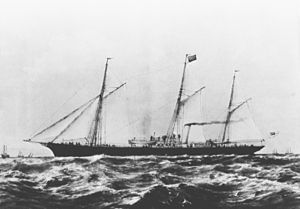
A steam yacht is a class of luxury or commercial yacht with primary or secondary steam propulsion in addition to the sails usually carried by yachts.
Origin of the name
Earliest steam yachts, luxury yachts, commercial yachts, naval yachts.
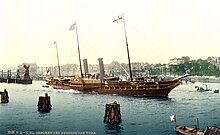
The English steamboat entrepreneur George Dodd (1783–1827) used the term "steam yacht" to describe the steamer Thames , ex Duke of Argyle . Her service on the river had first been advertised on 22 June 1815 as "Thames Steam Yacht", intended to emphasise how luxurious these vessels were. [1] [2]
The first two private steam yachts known were:
- Endeavour , wooden paddle steamer registered 28 January 1828 by builders Rawlinson and Lyon, Lambeth , 75’6” x 12’ x 7’2”, 25 tons with a 20 HP Maudslay patent [3] oscillating engine with two cylinders 20in. dia. X 2 ft. stroke, and registered to the eminent English engineer Henry Maudslay , [4] London on 21 February 1828, who used her as his private steam yacht. The eminent Scottish engineer James Nasmyth mentions a trip aboard her to Richmond. [5]
- Swift , wooden sailing smack built in 1803 at Bridport by Booles & Good, not registered. Unknown owners at Leith in 1804; documents missing. [6] Converted to a paddle steamer, described as a steam yacht, and registered by T. West, H. Bellingham, E. H. Creasey and others of Brighton on 21 August 1822 at Shoreham-by-Sea , 106’5” x 23’1” x 10’8”, 143 tons. They ran her as a ferryboat between Brighton and Dieppe . [7] [8] She was sold to G. Crichton, R. Ogilvie & others in Leith in February 1824. [9] Crichton & Ogilvie were well-known managers. [10] She was sold to H. Templer in London in September 1827 [11] and finally to Turkey in October 1828 when she became the Sultan's steam yacht Surat , [12] later taken in to the Ottoman Navy as its first steam vessel.
Thomas Assheton Smith II was excluded from the Royal Yacht Club for his championship of the steam yacht, eight of which he commissioned between 1830 and 1851, beginning with the Menai . [13] [14] In cooperation with the Scottish engineer Robert Napier , whose Govan, Glasgow yard built a number of them, Smith did much to improve the hull design of steam yachts. [15] After 1856, when the Royal Yacht Squadron (the Club became Squadron in 1833) removed their edict, steam yacht building began to multiply. [16]
In England around 1901, some steam-powered fairground swings attempted to recreate the steam yacht experience; one example was built by the fairground equipment engineer Frederick Savage. [17]
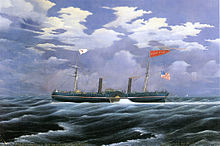
The term "steam yacht" encompasses vessels of several distinct uses, but of similar design.
A luxury yacht in the modern sense is a vessel owned privately and used for pleasure or non-commercial purposes. Steam yachts of this type came to prominence from the 1840s to the early-20th century in Europe . The first British royal yacht was Victoria & Albert of 1843. Nominally the first steam yacht in the United States was Cornelius Vanderbilt 's North Star , launched in 1854; however, this was actually a full-size steamship fitted out for the personal use of Vanderbilt and his family, and left no legacy on steam yacht design. [18] The first true steam yachts known to have been built in the United States, Leonard Jerome ' s Clara Clarita and R. F. Loper ' s Wave , were completed in 1864. [18]
Steam yachts were commissioned by wealthy individuals and often heads of state as extravagant symbols of wealth and/or power. [19] They were usually built with similar hull-lines to clipper ships , with an ornate bow structure and a low, smooth freeboard. Main propulsion usually came from one or two steam engines, later of compound type, or in even later, very large yachts, triple expansion or turbines . Steam yachts usually carried rigging for sails, originally as an auxiliary propulsion system, but later more for show and naval tradition. Private steam yachts were capable of long seagoing voyages, but their owners' needs and habits saw most stay near to the coast. Inland seas such as the Baltic and the Mediterranean were popular areas for using steam yachts.
Statistics show that Clydeside was the premier building area for steam yachts in the United Kingdom: 43 shipbuilding yards on Clydeside built 190 steam yachts between 1830 and 1935. [ citation needed ] Scotts Shipbuilding & Engineering Co Ltd of Greenock Scotland built 23 steam yachts between 1876 and 1904. [20]
The auxiliary steam yacht is a class of steam yacht in the luxury category. In 1876-77, British politician Thomas Brassey took his wife and children on a world cruise in their newly built yacht, the 532 ton Sunbeam . Brassey preferred sail as the primary source of motive power, but knew from years of experience the advantages of steam power, when wind and tide made progress difficult. Sunbeam was, therefore, designed as a "steam auxiliary", capable of covering long distances between coaling stations under her fully rigged sail area of 9200 square yards, but with enough fuel to steam for up to 20 days if necessary (she could carry 80 tons of coal). Their trip was made famous by a book written and published by his wife Annie Brassey - A Voyage in the Sunbeam, our Home on the Ocean for Eleven Months . Within a few years other yachts were built for owners with a similar sense of adventure, famously Lancashire Witch for Sir Thomas George Fermor-Hesketh, 7th Baronet and Wanderer for Charles Joseph Lambert. These sailing yachts, with steam auxiliary power, were more expensive to build and run, but gave the owners the freedom to roam the world without necessarily planning their routes via the network of coaling stations in existence at this time. In addition the yacht masters were not totally reliant on the quality of the steaming coal available to them, that could at times be questionable. When not in steam, the funnel on the auxiliary yacht would be lowered and the propeller feathered to reduce drag. [21]
Those of the second class of steam yacht were built for commercial use, but gained the 'yacht' title due to their size and design similarity with the private vessels and because they were not constructed to be mainly cargo- or passenger-carrying vessels, but as versatile, low- draft ships capable of working local coastal routes. This is closer to the original meaning of the word "yacht", coming from the Dutch term Jacht , describing a small, fast commercial vessel. The distinction between a commercial steam yacht and a coastal trading vessel is not a clear one, but the latter term usually implies a mainly cargo-carrying ship. Steam yachts were often run by packet companies operating regular, timetabled services between islands or coastal towns. Steam yachts were widely used in the whaling trade.
The light, fast design of a steam yacht was ideal for chasing whales, and the lack of a large amount of cargo space did not matter as whaling produced few bulky products. Commercial steam yachts were rarely as ornate or luxurious as their private counterparts, with simpler, more rugged lines and usually a more practical sailing rig. Steam yachts used in the whaling trade often had reinforced hulls to allow them to operate amongst the ice of frozen waters.
This meant that several whaling-yachts crossed the definition from commercial to private yacht in later life when they were bought for polar exploration work. Since these expeditions were, by and large, privately funded the ships used became, by definition, private steam yachts and many were registered with the 'SY' prefix used for such craft. The Aurora , Morning , Nimrod , Terra Nova and the Quest are all examples of commercial vessels that went on to become steam yachts used during the Heroic Age of Antarctic Exploration . It was common for expedition leaders to be members of a yacht club , so many of these ships were registered to a civilian club and flew a club burgee (and a blue ensign in the case of British steam yachts). Ernest Shackleton's ship Endurance and Roald Amundsen's Fram are unusual cases of vessels being purpose-built as icebreaking private steam yachts. Endurance was originally built for conducting tourist cruises of the Arctic, bringing her close to the definition of a yacht in the modern sense.
The Royal Navy used small numbers of steam yacht-type vessels from the Victorian era onwards to transport men and equipment in harbour, act as coastal escorts for larger ships and for training and exercises. A good example of this was the iron p.s. Fire Queen built for the entrepreneur Thomas Assheton Smith (II) (1776–1858), (his first of three Fire Queen ' s) by Robert Napier, Govan, Glasgow and launched on 27 July 1844, Napier Yard No 5, engine No 88. [22] She was bought by the British Admiralty in July 1847 for £5,000 for use as a tender; there is an illustration (incorrectly captioned) of her in that role. [23] She was sold on 4 August 1883 for £1,100 by the Admiralty to Castle the shipbreakers. [24] Fire Queen was replaced by the Admiralty by the former Steam yacht Candace , launched on 23 September 1881 by Ramage & Ferguson, Leith, bought by the Admiralty in 1882 and then duly renamed Fire Queen . [24]

In the First World War vessels such as these and several requisitioned private yachts were used on anti- U-boat patrols and for minesweeping . It became clear that the naval trawler was more suited to these kinds of tasks.
Steam yachts often used the ship prefix SY , but some were alternatively described as screw schooner , if they carried schooner rig. A fine example of the screw schooner is the 125 year old British Amazon , built at Southampton in 1885 from designs by the renowned Dixon Kemp and still in use in the USA after crossing the Atlantic in 2009, although diesel-propelled since 1937. She was photographed on Columbus Day 2009 on a mooring near the Herreshoff Marine Museum in Bristol, Rhode Island . [25]
Aurora built by Alexander Stephen & Sons Ltd, Glasgow in 1876 (a former whaling-yacht turned Antarctic exploration vessel) is a notable example of the class, as are the Victorian era yachts used by European monarchs , such as the HMY Victoria and Albert III and the SMY Hohenzollern . One of the oldest steam yachts, and one of the few still surviving today, is the Kheideval Yacht, Mahroussa , which was built in 1865 and was maintained in seaworthy condition by the Egyptian government.
The Hildegarde and Hiawatha were steam yachts chartered by the Ministry of Agriculture, Fisheries and Food (United Kingdom) - Directorate of Fisheries, now known as the Centre for Environment, Fisheries and Aquaculture Science (Cefas) between 1912 and 1914 to carry out fishery investigations. [26] Before the First World War , the SY Hildegarde was renamed as the Managem . On 15 January 1917 she was requisitioned by the Admiralty and armed with a 12 pdr naval gun. Notably she was stationed off Atlit in Israel and used to relay espionage messages from operatives onshore (and briefly used by the Jewish "Nili" espionage group).

Related Research Articles

A steamship , often referred to as a steamer , is a type of steam-powered vessel, typically ocean-faring and seaworthy, that is propelled by one or more steam engines that typically move (turn) propellers or paddlewheels. The first steamships came into practical usage during the early 1800s; however, there were exceptions that came before. Steamships usually use the prefix designations of "PS" for paddle steamer or "SS" for screw steamer . As paddle steamers became less common, "SS" is assumed by many to stand for "steamship". Ships powered by internal combustion engines use a prefix such as "MV" for motor vessel , so it is not correct to use "SS" for most modern vessels.

Thomas Brassey, 1st Earl Brassey , was a British Liberal Party politician, Governor of Victoria and founder of The Naval Annual .

Robert Napier was a Scottish marine engineer known for his contributions to Clyde shipbuilding.

HMS Waterwitch was a British hydrographic survey vessel active in eastern Asian waters from 1894 to 1912. She was a wooden vessel, purchased from a private owner specifically for survey work. She was lost in a collision in Singapore harbour in 1912.

HMS Eclipse was a Royal Navy Cruizer -class brig-sloop built by John King at Dover and launched in 1807. She served off Portugal and then in the Indian Ocean at the capture of the Île de France. Shortly thereafter she captured Tamatave. She was sold for mercantile service in 1815. She traded with India until 1823. Then between 1823 and 1845 she made seven voyages as a whaler.

SS Archimedes was a steamship built in Britain in 1839. She was the world's first steamship to be driven successfully by a screw propeller.

George Lawley & Son was a shipbuilding firm operating in Massachusetts from 1866 to 1945. It began in Scituate, then moved to Boston. After founder George Lawley (1823–1915) retired in 1890, his son, grandson and great-grandson upheld the business, which continued until 1945. Of the hundreds of ships built by the Lawleys, highlights include the yachts Puritan and Mayflower , respective winners of the 1885 and 1886 America's Cup.
St Clare John Byrne (1831-1915) was a British naval architect, who specialized in the design of luxury yachts during the late Victorian and early Edwardian period.
William Patterson Shipbuilders was a major shipbuilder in Bristol, England during the 19th century and an innovator in ship construction, producing both the SS Great Western and SS Great Britain , fine lined yachts and a small number of warships.

HMS Rover was a Royal Navy Cruizer -class brig-sloop laid down in 1804 but not launched until 1808. She served in the North Sea, off the north coast of Spain, in the Channel, and on the North American station. She captured two letters-of-marque and numerous merchant vessels before being laid-up in 1815. She then sat unused until she was sold in 1828. She became a whaler that made four voyages to the British southern whale fishery between 1830 and 1848. She was last listed in 1848.

Sunbeam , a British luxury yacht launched in 1874, became famous when Annie Brassey, the wife of its owner Thomas Brassey, published a book describing their adventures during a world cruise. The book, titled A Voyage in the Sunbeam, our Home on the Ocean for Eleven Months , became a best seller and was translated into many languages.
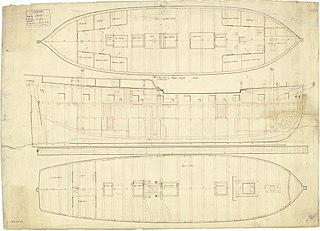
HMS Rattler was a 16-gun sloop of the Royal Navy. Launched in March 1783, she saw service in the Leeward Islands and Nova Scotia before being paid off in 1792 and sold to whaling company Samuel Enderby & Sons. She made two voyages as a whaler and two as a slave ship before she was condemned in the Americas as unseaworthy in 1802. She returned to service though, sailing as a whaler in the northern whale fishery, sailing out of Leith. She continued whaling until ice crushed her in June 1830.
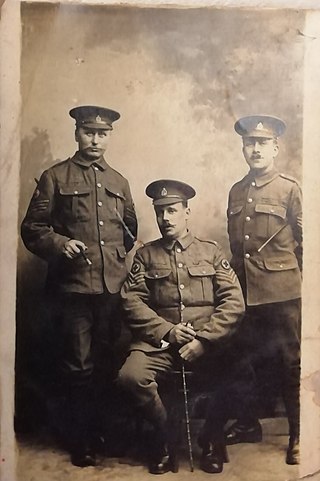
City of Edinburgh may refer to a number of ships, all named after the city of Edinburgh, Scotland:

HMS Indian was a Bermuda-built sloop launched in 1805. She captured several small privateers while on the West Indies and Halifax stations before the Royal Navy sold her in 1817. Her main claim to fame, however, is that she was the first command of future Rear-Admiral Charles Austen, who was also the brother of the famed novelist Jane Austen. After the Navy sold her she became a whaler for Samuel Enderby & Sons. She apparently sailed for them until the mid-1830s; she then sailed for other owners until mid-1847, for a total of nine whaling voyages since leaving naval service.

Rifleman was a Cruizer -class brig-sloop launched in 1809 for the Royal Navy. She served in the North Sea, on the Halifax and Jamaica stations, and in the Mediterranean Sea. During her service she recaptured a Royal Navy vessel in Danish service, and two privateers. The Navy sold her in 1836 and she proceed to sail as a merchantman and whaler between 1837 and 1856.
HMS Nimrod was a brig-sloop of the British Royal Navy, launched in 1812. She spent her war years in north American waters where she captured one small privateer, assisted in the capture of another, and captured or destroyed some 50 American vessels. After the war she captured smugglers and assisted the civil authorities in maintaining order in Tyne. She was wrecked in 1827 and so damaged that the Navy decided she was not worth repairing. A private ship-owner purchased Nimrod and repaired her. She then went on to spend some 20 years trading between Britain and Charleston, the Mediterranean, Australia, and India. She was last listed in 1851.
HMS Coquette was launched in 1807 and spent her naval career patrolling in the Channel and escorting convoys. In 1813 she engaged an American privateer in a notable but inconclusive single-ship action. The Navy put Coquette in ordinary in 1814 and sold her in 1817. She became a whaler and made five whaling voyages to the British southern whale fishery before she was lost in 1835 on her sixth.
Norfolk was built in France in 1784 under a different name. The British captured her c. 1800 and she made some voyages as a West Indiaman. She also made a cruise as a privateer. Between 1803 and 1808 she served the Royal Navy as an armed defense and hired armed ship on the Leith Station. She spent her time escorting convoys in the North Sea and captured one French privateer. After her naval service, between 1808 and 1814 Norfolk was a London-based transport. From 1814 to 1820 she made four voyages as a whaler in the British southern whale fishery. She was last listed in 1823.
The SY Hildegarde and the SY Hiawatha were steam yachts chartered by the Ministry of Agriculture, Fisheries and Food - Directorate of Fisheries, now known as the Centre for Environment, Fisheries and Aquaculture Science (Cefas) between 1912 and 1914 to carry out fishery investigations.
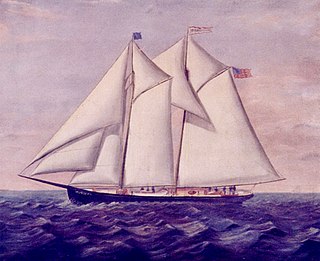
The Thomas F. Bayard was a 19th-century Delaware River pilot schooner built by C. & R. Poillon shipyard in 1880. She spent sixteen years as a pilot boat before being sold during the Yukon Gold Rush in 1897. She was sold again in 1906 for Seal hunting, then purchased by the Department of Marine & Fisheries where she guided freighters into New Westminster, British Columbia for 43 years. She was then acquired by the Vancouver Maritime Museum in 1978. When she sank at her mooring in 2002, the International Yacht Restoration School, Mystic Seaport and the Vancouver Maritime Museum, removed the vessel in pieces for the archeological teams to study and document the remains of her hull. The Thomas F. Bayard Collection , at the Vancouver Maritime Museum, contains the documents, history and preservation efforts.
- ↑ Parliamentary Report of 24 June 1817, 29
- ↑ British Patent No. 3050, 1807, "Steam Engines"
- ↑ The National Archives BT107/52, No. 55
- ↑ Nasmyth, James (1883). James Nasmyth, Engineer: An Autobiography . London: John Murray . p. not cited.
- ↑ Hawks, Fred, World Ship Society CD No. 2
- ↑ The National Archives, BT107/169, Shoreham No.15.
- ↑ Parliamentary Report 1822, page 201.
- ↑ BT107/408.
- ↑ Martine, John (1888). Reminiscences of the port and town of Leith . Edinburgh: John Martine. p. 4.
- ↑ "Piece reference BT 107/51—Registry of Shipping and Seamen: Transcripts and Transactions, Series I—London Foreign Trade—Ports: 277 - 503, No. 379" . The Catalogue . The National Archives .
- ↑ "Piece reference BT 107/51—Registry of Shipping and Seamen: Transcripts and Transactions, Series I—London Foreign Trade—Ports: 277 - 503, No. 383" . The Catalogue . The National Archives .
- ↑ Boase, George (1885). Smith, Thomas Assheton (DNB00) . Vol. 53. Smith, Elder & Co – via Wikisource .
- ↑ Dawson, C (August 2006). "Thomas Assheton Smith's Steam Yachts". The Mariner's Mirror . 92 (3).
- ↑ Eardley-Wilmot, Sir John E., ed. (1860). Reminiscences of the late Thomas Assheton Smith, Esq . London: John Murray. p. 55 .
- ↑ Kemp, Dixon , Steam Yachts , RINA 24th Session, 15 March 1883
- ↑ "Fairground Sale Steams Ahead" . BBC News online. 11 October 2002.
- 1 2 Stephens, William Picard (1904). "Steam Yachting in America". American Yachting . New York: The MacMillan Company. pp. 399–342 .
- ↑ Marine Engineering . Vol. 4. Marine Publication Co. 1899. pp. 142–144.
- ↑ Two Centuries of Shipbuilding by the Scotts at Greenock . London: Scotts. 1906.
- ↑ Brassey, Earl Thomas (1917). Sunbeam RYS. Voyages & Experiences in Many Waters . London: John Murray. p. Chapter V.
- ↑ World Ship Society Yard List No 169/5.
- ↑ Gardiner, Robert, ed. (1993). The Advent of Steam: The Merchant Steamship Before 1900 . Conway's History of the Ship. London: Conway Maritime Press. p. 36. ISBN 0851776183 .
- 1 2 Lyon, David; Winfield, R (2004). The Sail and Steam Navy List: All the Ships of the Royal Navy, 1815-1889 . London: Chatham Publishing. p. 286. ISBN 1861760329 .
- ↑ "1885 British screw schooner Amazon at Bristol RI Columbus Day 2009" . Archived from the original on January 8, 2011 . Retrieved March 24, 2011 .
- ↑ MAFF (1992). The Directorate of Fisheries Research: Its Origins and Development . Ministry of Agriculture, Fisheries and Food, Lowestoft. 332pp.

EAST DO NYLAND / ROWHEDGE
S.y. varuna .
If ever a millionaire enjoyed spending his money it was Eugene Higgins.
Born 14 July 1860 in Manhattan Eugene Higgins was the rich heir to a carpet-making business. Graduating from Columbia University in 1882 he went into banking but spent most of his life his spending money.
He was a devoted golfer, cross-country rider, fisherman, hunter, coach racer, yachtsman, fencer and amateur enthusiast in physics and mathematics. After studying fencing in France he became, in 1890, America’s first fencing (epee) champion. His luxurious steam yacht Varuna was named after the Hindu god of the ocean.
Higgins owned a townhouse at Fifth Avenue and Thirty-fourth Street (at the intersection that is now the Empire State Building) which was a magnet for high society, and a country home at Morristown, New Jersey.
Columns in the society pages of newspapers were devoted to his exploits, his horses, his dogs and his schemes for entertaining the idle rich . It was said that he had "sumptuous pleasure campaigns" for his friends mapped out by the season, with no refinement overlooked.
A description of Higgins states that "Mr. Higgins is not only the richest but the handsomest unmarried New Yorker,", and goes on to mention "Sartorially, he is all that can be desired."
He willed the bulk of his $38,500,000 estate for "education in natural and physical sciences" before he died in the summer of 1948. Columbia, Yale, Princeton and Harvard share the income from one of the largest trust funds ever given to educational institutions to “promote the general advancement of science by investigation, research, and experiment."
Below - Eugene Higgins

THE DUNDEE COURIER - Wednesday 15 July 1896 - “LAUNCHES ON THE CLYDE - .... Messrs. A. & J. Inglis, Pointhouse, launched yesterday the Varuna , a twin-screw steel yacht of 1500 tons, built for Mr. Eugene Higgins, New York.....”
THE YACHTING WORLD - October 1896 - Capt. Trayler (ex La Belle Sauvage ) of Wivenhoe has been appointed to s.y. Varuna . The same issue also notes that a crew of 40 men had left Rowhedge to join Varuna .
THE GLASGOW HERALD - 13 November 1896 - “THE STEAM YACHT VARUNA - The twin-screw yacht Varuna , which has been designed by Mr. G.L. Watson and built by Messrs. A. & J. Inglis, Pointhouse, for Mr. Eugene Higgins, New York, went on a trial trip yesterday in the Firth of Clyde. On the previous day she had completed her progressive trials very satisfactorily, and there was little doubt that she would go through the severer tests as easily. Her boats, which have been built by Mr. Peter McLean, Roseneath, were got on board in the morning, and she left the Tail of the Bank shortly after ten o’clock. Two runs each way were made between the Cloch and the Cumbrae, and with everything working splendidly for a new boat of the class, a mean speed of just on 17 knots was the result.
This morning she starts on a 24-hours coal consumption trial, and as soon as possible next week will proceed direct to New York. Mr. Jas. Gordon Bennett comes north on Saturday to look over the yacht, which will rank as one of the finest and most luxuriously fitted of the pleasure fleet at present under construction on the Clyde for America. The work is of the best, as everything is which comes from Pointhouse, and under the supervision of Mr. Watson nothing has been left undone to make the Varuna the ideal yacht her owner desires. Internally there is a lot yet to do, but even amidst the chaos which always precedes the finishing touches in the construction of a boat there is abundant evidence of the advance which the newer Watson steamers make. She is fitted and furnished magnificently, and in her completed state will provide the shipbuilders of the United States with a lesson rather difficult to follow. Captain Trayler, of Wivenhoe, is in command, and amongst the crew of 16 there are several well-known racing hands from the Colne.”
THE SHEFFIELD AND ROTHERHAM INDEPENDENT - Friday 20 November 1896 - “The yacht Varuna , which has been built by Messrs. A. and J. Inglis, Partick, for Mr. Eugene Higgins, New York, is the most sumptuous yacht that has ever left the Clyde. Of 1,520 tons Thames measurement, the Varuna is built of steel throughout. It is to the size of her bridge deck that the Varuna owes, in greatest measure, the exceptional character of her accomodations. Her deck is 168ft. in length. the dining room is about 18ft. by 34ft. It is fitted up in panelled oak. The library has an area of some 187 square feet, and a total wall length of 50ft., enough to allow of bookcases containing a plentiful supply of literature. This library is aft of a series of rooms for maids and valets and lavatories and bathrooms for guests, arranged along the casing on the starboard side, and alongside the after end of the dining room is a vestibule floored with rubber tiling. Passing abaft the engine room, you come to a drawing room 18ft square, and the fencing room, nearly as large, which is provided with cabinets, racks for foils, dumb-bells, clubs and other accessories for physical exercise. There are magnificent state rooms some in white, some in mahogany, a large bachelors’ room, bathrooms, a doctor’s room, and so on. The guests’ rooms will be upholstered in luxurious fashion.”
THE YACHTING WORLD - 20 November 1896 - “SEA BREEZES - The fine steam yacht Varuna , just built by Messrs. A. & J. Inglis, of Point House, to the design of Mr. G.L. Watson, for Mr. Eugene Higgins, a well-known member of the New York Yacht Club, underwent a series of severe trials last week on the Clyde. Mr. Watson and the builders were of course on board the boat during the trials, which turned out as satisfactory as anyone could wish. Eight runs on the measured mile at Skelmorlie resulted in a mean speed of 16¼ knots an hour being attained, the engines during the trial working with every satisfaction. Another trial between the Cloch and the Cumbrae light showed an even better result, close on 17 knots an hour being chronicled. The average speed of the official trial was 16.75 knots an hour, the contract speed being 16.5 knots. The engines ran smoothly, without a hitch, making 160 revolutions a minute at 160lb. per inch steam pressure and 37lb. vacuum.
The Varuna , as will be seen from the photograph reproduced in the present issue, has a fully curved clipper bow nicely set off by an artistically carved figurehead. The stern, which is elliptical, is quite in harmony with the stem, being considerably drawn out, therefore giving big overhangs. The dimensions of the Varuna are:- Length on load-water line, 260ft.; depth moulded, 18.3ft.; breadth, 35.1ft.; while the tonnage according to Thames measurement is 1,500 tons. The yacht was coaled on Tuesday, and was expected to leave the Clyde for New York to-day (Thursday). It is anticipated that the Varuna will average 14 knots an hour on her journey across the Atlantic.”

THE GLASGOW HERALD - Thursday 5 December 1896 - “ARRIVAL OF THE VARUNA - (Telegram from Special Correspondent) - New York, December 1.- Mr. Eugene Higgins’s fine new steam yacht the Varuna arrived here to-day from Greenock, after a satisfactory first voyage.”
THE YACHTING WORLD - 11 December 1896 - “ VARUNA’S VOYAGE - PARTICULARS OF THE LOG OF THE TRIP ACROSS THE ATLANTIC - The New York Herald gives the following particulars of the trip of the Varuna across the Atlantic:- The Varuna’s maiden voyage was made in stormy weather, but the yacht behaved splendidly. Not a screw or bolt was loosened.
Captain Taylor (sic) says:- “I never sailed a better boat. I could have come straight across, if necessary, but my instructions were to take things easy. We left Glasgow on the Saturday night. There was a great wind and the sea was so heavy we thought every minute we would stick our nose under, but the ship lifted to the waves like a cork, and practically no water got aboard. Having new engines and gear, we did not care to strain her. The weather grew thicker and heavier and finally we decided to put into Lough Swilly until it abated. It took us just eight days and twenty-one hours to make Sandy Hook from Lough Swilly, which is pretty good time. The storm did practically no damage. On the second day out the sea burst through the forward port, which is likely to happen to any ship. The wind drew so hard that we kept bearing off a trifle. In the evening of the same day the wind was north-west and blew great guns. The boat behaved nobly but we did not care to take chances, so we kept her off a few points.”
The Varuna anchored off Bay Ridge, and Mr. Eugene Higgins, who went aboard her, said:-
“I am highly satisfied with the Varuna’s excellent sea qualities and general appearance. There is no question but that the builders of Europe have more advanced ideas of the construction of ships than we. The Varuna reached port with not a bolt strained. There is no sign of repairs needed either to the boiler or the engines. The heavy weather gave an opportunity to show her seaworthiness. The log shows that she is not deficient in speed. My orders were not to try for speed but to ensure safety. I start on December 12th with ten or twelve friends, stopping at Bermuda, Madeira, Gibraltar and Marseilles, and will continue my cruise in the Mediterranean until Spring.”
The Varuna’s log shows her record as follows:-
Leaving the Irish coast on Monday noon, to Tuesday noon, 301 miles; moderate gale, heavy sea, wind south-west to west, sky overcast.
Wednesday, 296 miles; strong west-south-west wind; heavy sea.
Thursday, 313 miles; strong breeze south-west to north-east.
Friday, 371 miles, strong north-east gale, tremendous sea.
Saturday, 310 miles; moderate gale, north-east to north; very heavy sea.
Sunday, 357 miles; fresh north-west winds; thick weather.
Monday, 371 miles; strong wind, east-north-east; moderate sea.
Tuesday, 357 miles; moderate wind and sea.
Wednesday, 238 miles; arrived at Sandy Hook 4.30 a.m.”
THE NEW YORK TIMES - 11 December 1896 - “RECEPTION ON THE VARUNA - Eugene Higgins gave a reception on his new yacht Varuna yesterday afternoon. The yacht was anchored in the North River off Thirty-eighth Street. Among those who inspected the yacht were Commodore E.M. Brown, Gouverneur Kortright, F.W.J. Hurst, and J.V.S. Oddie. The Varuna will sail for Gibraltar to-morrow.”

THE NEW YORK TIMES - 13 December 1896 - “SOCIETY’S WINTER SEASON - .... Mr. Eugene Higgins gave a “stag” reception on his beautiful new steam yacht Varuna on Thursday afternoon, which was attended by all the prominent members of the New York and Seawanhaka Yacht Clubs and by a large number of Mr. Higgins’s personal men friends. The Varuna was greatly admired, and a handsome collation which followed the reception was enjoyed. Mr. Higgins sailed for Gibraltar on the Varuna yesterday.”
THE YACHTING WORLD - 1 Jan 1897 - “SEA BREEZES - The Varuna , Mr. Eugene Higgins’ steam yacht, just built on the Clyde, arrived at Madeira on Saturday from the Bermudas, having steamed the distance of 2,435 miles in seven days and sixteen hours.”

THE NEW YORK TIMES - 3 March 1897 - “FOREIGN NOTES OF INTEREST - La Valetta, Malta, March 2.- The steam yacht Varuna , owned by Mr. Eugene Higgins of New York, arrived here to-day. The Varuna sailed from New York Dec. 11, and called at Bermuda, Madeira, Gibraltar, and Marseilles.”
THE MORNING POST - Friday 23 April 1897 - “SHIPPING INTELLIGENCE - Home Arrivals - Greenock: April 21 - Varuna (steam yacht), Marseilles....”
THE NEW YORK TIMES - 24 April 1897 - “ PERSONAL - American merchantmen are lamentably scarce in the Mediterranean nowadays, but the owners of yachts are doing their best to prevent the Stars and Stripes from passing quite out of memory in those waters. The writer of a letter just received here says that when in Venice toward the end of last month, he saw our flag flying from three magnificent steam yachts that were anchored off the Piazza San Marco at the same time. They were the Varuna , owned by Anthony (sic) Higgins; Anthony J. Drexel’s Margarita , and the May , which belongs to Mrs. Sarah Drexel Fell. They are all floating palaces, well calculated to excite the awe and admiration of foreigners, and to fill with pride such chance observers from the United States as didn’t take the trouble to recall that every one of these bearers of his country’s banner was built on the Clyde. The Varuna was on her way to Marseilles, where she arrived on the 28th, after circling the inland sea in less than a month, and calling at Villefranche-sur-Mer, Monaco, Malta, Alexandria, several towns in Crete, Zante, and Paxos, and the Austrian naval station at Pola. Among Mr. Higgins’s guests were Major Glentworth, of the Austrian Army, Charles Le Goy of New York, and Mr. Wood of Morristown, N.J. The cruise, as can well be imagined, was an enjoyable one, for the Varuna’s passengers were able to get a close view of war as it is understood in Crete, and participated in many impressive social functions at the more peaceful ports in which they anchored.”
THE GLASGOW HERALD - Tuesday 4 May 1897 - “SAILINGS FROM FOREIGN PORTS - Varuna (s), Colne from Kiel, May 3.”
THE HAMPSHIRE ADVERTISER - 5 May 1897 - “YACHTING - The American-owned steam yachts Varuna and Margarita arrived in the Clyde last week from the Mediterranean and both will undergo extensive overhauls....”
THE NEW YORK TIMES - 23 May 1897 - [Yachting] - Besides the two steam yachts for Ogden and Robert Goelet there are at present in the Clyde two other leviathan steam yachts, owned by American millionaires. These are the Margarita , built last Autumn on the Clyde [Gourock] for Mr. [Colonel A.J.] Drexel of Philadelphia [to Troon Shipbuilding Company’s yard], and the Varuna , built during the past Winter by Messrs. Inglis of Glasgow [to Inglis’ yard]. These four steam yachts were designed by G.L. Watson, and their internal fittings by his cousin, Thomas Watson of Glasgow. The Margarita and the Varuna (built for Mr. Higgins of New York) have returned to the Clyde, after cruising in the Mediterranean, to have an overhaul and clean-up previous to another cruise to complete the season. It is not reported what the intentions of the owners may be, but it is surmised that some of these American yachts will attend the yacht race from Dover to Heligoland for the German Emperor’s Jubilee Cup and do honor to the occasion.”
Additions [ ] from The Belfast News-Letter 26 April 1897.
THE ESSEX COUNTY CHRONICLE (Chelmsford) - Friday 9 July 1897 - “How sweet must be the sleep of the owner of the great steam yacht Varuna , which has just left the Colne for Southampton, and thence for New York.
The Varuna is the largest yacht that ever entered the Colne, and it is one of the best appointed vessels known. Its elaborate furniture includes a silver-plated bedstead, where the owner passes his nights.
Only fancy - rocked by the silvery waves on a silver-plated bedstead!
The steam yacht Nerissa has returned to the Colne after a successful cruise to Norway. She is shortly to proceed on a coasting tour.”
THE HAMPSHIRE ADVERTISER - 17 July 1897 - “SOUTHAMPTON YACHTING NEWS - ...[Departures] ....the Varuna , s.s., Mr. Higgins, for New York....”
THE NEW YORK TIMES - 24 July 1897 - “MR. HIGGINS’S VARUNA IN PORT - Her Owner Home from a Long Voyage South and in Europe - The steam yacht Varuna arrived in port yesterday morning from an extended cruise in European waters. Eugene Higgins, her owner, and several guests returned home in the yacht.
The Varuna left New York Dec. 12 last, and visited numerous places of interest in the West Indies and in Southern Europe. She also visited ports in the British Isles. She left Southampton for the return July 10, calling at St. Michael’s for coal, and sailing from there July 16. Moderate and variable weather was experienced during the voyage.
Mr. Higgins’s guests were Mr. and Mrs. Andrews, Baron de Heckerer, Allan Arthur, son of the ex-President; L.F. Gregory, W. Wood, Dr. Domingoe, and Charles Le Goy.
The Varuna registers 1,166 tons, and carries a crew of fifty-nine men. She has twin screws, and was built in 1896 on the Clyde, by Inglis & Son. She proceeded to Bay Ridge, where the owner and his guests disembarked, coming thence to the city.”
THE NEW YORK TIMES - 6 August 1897 - “YACHTING - NAVAHOE BEATS VIGILANT - Royal Phelps Carroll Wins His Second Goelet Cup in an Exciting Contest.... Newport, Aug. 5.- .... defeating the Vigilant by 1 minute and 1 second elapsed time.... Among the yachts out to see the race were.... Eugene Higgins’s Varuna ....”
THE NEW YORK TIMES - 20 August 1897 - “NEWPORT, R.I., Aug. 19 - The following yachts arrived here to-day.... steamer Varuna , owned by Eugene Higgins.”
THE NEW YORK TIMES - 27 August 1897 - “NEWPORT, R.I., Aug. 26 - ....Yachts in the harbor: steamer Varuna , owned by Eugene Higgins....” Noted as being in port until 9th September.
THE NEW YORK TIMES - 5 September 1897 - “EVENTS OF THE WEEK - The most notable events of the past week at Newport were.... There were also receptions on Mr. Higgins’s steam yacht Varuna and numberless dinners and luncheons....”
THE NEW YORK TIMES - 10 September 1897 - “NEWPORT, R.I., Sept. 9.- The departures were as follows.... steamer Varuna , owned by Eugene Higgins....”
THE NEW YORK TIMES - 25 November 1897 - “ Varuna to Start on a Long Cruise - E.S. Higgins, New York Yacht Club, has completed arrangements for a protracted cruise on his steam yacht Varuna . Mr. Higgins will be accompanied on his voyage by several friends, among them Chatfield Taylor, the golfer. The yacht is ready for sea, and will leave port to-morrow, and after a few weeks among the West Indies will cruise along the coast of South America, and thence to Africa and the Mediterranean.”
THE NEW YORK TIMES - 6 February 1898 - “Eugene Higgins is cruising in the Mediterranean with a party of friends on the steamer Varuna , and will go to Cannes in time for the regattas. Mr. and Mrs. John R. Drexel will be there on board the Sultana as will Mr. and Mrs. Anthony J. Drexel, on the steamer Margarita . Robert Goelet’s Nahma and Henry Walter’s Narada will also be there.”
THE GLASGOW HERALD - Monday 2 May 1898 - [The Spanish - American War] - “THE AMERICAN YACHTS IN THE MEDITERRANEAN - New York, May 1.- The reported chase of Mr. Gordon Bennett’s yacht makes it interesting to recall the names and owners of valuable yachts now in the Mediterranean, and therefore liable to chase and capture by the Spanish Government. They are:- .... the Valiant , Willie Vanderbilt; the Margarita , Mr. Anthony Drexel; the Varuna , Mr. Eugene Higgins; the Sultana , Mr. John Drexel, and the Namouna , Mr. Gordon Bennett....”
The Namouna was chased by a Spanish flotilla and took refuge at Cannes.
EVENING STAR (Ipswich) – Friday 16 September 1898 – “COLNE OYSTER FISHERY – THE OPENING CEREMONY." Varuna was in attendance for the event in the river Colne.
THE NEW YORK TIMES - 7 November 1898 - “Mr. Higgins, as already announced, is expected daily with his yacht, the Varuna , which sailed from Bordeaux last week.”
THE NEW YORK TIMES - 15 November 1898 - “EUGENE HIGGINS HOME - Eugene Higgins and a party of friends arrived from Europe yesterday on Mr. Higgins’s steam yacht Varuna . The Varuna left New York nearly a year ago for a cruise in European waters. She was at Venice when the [Spanish - American] war broke out, and a regard for the possibilities of an encounter with Spanish gunboats, known to be on the lookout for American yachts, led to her being laid up till the cessation of hostilities, when she went to Southampton. She left that port for the homeward trip Oct. 21, stopping at Bordeaux, whence she sailed Nov. 1. and Funchal, Madeira, Nov. 5.”
THE NEW YORK TIMES - 28 November 1898 - New York experienced the worst November snowstorm on record with 9.7 inches of snow falling. The storm which raged throughout Saturday night and into Sunday blocked streets, prevented travel, delayed passenger liners and played havoc with sailing vessels.... “E.S. Higgins’s big yacht the Varuna was threatened with destruction during the night, as she began to drag her anchors and work in toward the Staten Island shore. An extra anchor was gotten over with thirty fathoms of chain, and this checked her, and she came out safely.”
NORTH-EASTERN DAILY GAZETTE - Tuesday 6 December 1898 - “NEWS IN BRIEF - At a dinner given by Mrs. Astor to Lord Strafford and his fiancée, the announcement was made that the wedding will take place on Tuesday morning next at the home of Mrs. Colegate’s sister. Bishop Potter will perform the ceremony, and only the immediate relatives of the family will attend. The Earl and Countess will make a honeymoon tour of the United States, sailing for home in January in the yacht Varuna , as the guests of its owner, Mr. Eugene Higgins.”
THE NEW YORK TIMES - 11 December 1898 - [Wedding of John R. Livermore and Miss. Josephine Whitney Brooks the following Wednesday] “Eugene Higgins, uncle of the bride, who came from Europe on his yacht Varuna to attend the wedding, will sail the same day on his return trip.”
THE NEW YORK TIMES - 19 December 1898 - “Eugene Higgins sailed last week just after the wedding of his niece, Miss. Brooks, to Mr. Livermore, in the Varuna , with a large stag party.”
THE NEW YORK TIMES - 20 March 1899 - “Eugene Higgins, before she sailed, gave a dinner on board his yacht, the Varuna , to Sir Thomas Lipton.”
THE BURY AND NORWICH POST - 23 May 1899 - “DANGERS OF SMALL SAILING BOATS - A sad boating accident occurred at Wyvenhoe, near Colchester, on Saturday evening. Two young men named Arthur Firmin and William Traylor, the latter being a son of Captain Traylor, of the steamship Varuna , left Wyvenhoe Quay for a sail down the river Colne in a fifteen feet drop keel sailing boat. When off Alresford Creek the craft was struck by a sudden squall, which caused her to heel to leeward. Owing to the shifting of the ballast she did not right herself, and the occupants jumped overboard and started to swim ashore. Traylor, finding that the boat did not sink, returned, and clung to the side, at the same time shouting to Firmin to do the same, and thrusting an oar towards him. Firmin, however, became quickly exhausted, and sank. Two lads named Pooley and Pleater, who witnessed the accident, put off in another boat and rescued Traylor, who was in a state of collapse. Firmin’s body was not recovered until low tide on Sunday morning. He was the only son of a widow.”
THE NEW YORK TIMES - 31 August 1899 - [Sir Thomas Lipton’s steam yacht Erin and Shamrock I were at New York for the America’s Cup challenge] “Visits were also exchanged between the Erin and Eugene Higgins’s steam yacht Varuna , which arrived with her owner and a party of friends after a ten-day voyage from Havre.”
THE NEW YORK TIMES - 2 September 1899 - “The steam yacht Varuna arrived from New York to-day with Eugene Higgins, the owner, and a party of guests on board.”
THE NEW YORK TIMES - 9 September 1899 - “Newport - Anchored in the harbor to-day are the steam yachts.... Varuna ....”
THE NEW YORK TIMES - 21 September 1899 - [America’s Cup challenger Shamrock I takes an exhibition spin for the benefit of American worthies and many spectators witnessed the proceedings from yachts] “Other yachts in the fleet were the Varuna , Armorica , and Sultana .”
THE NEW YORK TIMES - 1 October 1899 - [Regarding the second America’s Cup race] Following a list of steam yachts which “will take out parties of guests, of whom the largest and most socially important will be on the Corsair , Narada , May , Vergana , Conqueror , Varuna , Atalanta , and Lorna .”
THE NEW YORK TIMES - 8 October 1899 - [America’s Cup races] “One of the most interesting features of the marine spectacle of Tuesday, Thursday and yesterday was the unprecedentedly large fleet of steam yachts which accompanied the cup contestants each day over the course.... The largest and most notable parties were carried every day by Mr. Pierpoint Morgan on Corsair , Mr. Eugene Higgins on Varuna ...” [And many others]
THE NEW YORK TIMES - 28 January 1900 - “The Varuna has also left Southampton for Nice, where she will be boarded by her owner, Mr. Eugene Higgins, who has arrangements made for a long cruise.”
THE NEW YORK TIMES - 30 January 1900 - “On the Riviera.... Eugene Higgins, who has been at Nice for some time, is experimenting with different kinds of electric and steam automobiles. His steam yacht Varuna is in port, and later he goes on a cruise. “
THE NEW YORK TIMES - 22 February 1900 - “In the harbor of Nice, last week, there were a number of English and American yachts, among them the Valiant and Varuna , on which last Mr. Higgins is entertaining.”
THE HAMPSHIRE ADVERTISER - 24 February 1900 - “YACHTING ITEMS - ....The Varuna , s.s., from Southampton, arrived at Palermo on Wednesday....”
THE NEW YORK TIMES - 27 February 1900 - “Eugene Higgins is on the Varuna , and from last cabled dispatches was at Naples.”
THE NEW YORK TIMES - 9 March 1900 - “Eugene Higgins. on the Varuna , has left Nice for Tunis.”
THE NEW YORK TIMES - 10 April 1900 - “Eugene Higgins, in the Varuna , has passed Gibraltar, westward bound.”
THE NEW YORK TIMES - 29 April 1900 - “Eugene Higgins is coming westward on the Varuna , and will be at Newport during the season.”
THE ESSEX COUNTY STANDARD - Saturday 12 May 1900 - “WYVENHOE - SMOKING CONCERT - On Wednesday evening, May 9, a capital smoking concert in connection with the arrival of the steam yachts Varuna and Rosabelle , and the departure of the yachts Surf and Gunilda was held at the Park Hotel, Wyvenhoe. A large company was present. Captain H. Harlow occupied the chair. Mr. F.J. Lax kindly presided at the piano, and Mr. A. Vinson, violin. During the evening the health of the Wyvenhoe Volunteers now at the front was drunk with musical honours. One of the chief features of the evening was the singing of Mr. Harry Dunstane, a humorous and descriptive vocalist of first-class talent, whose songs elicited loud applause, being rendered in great style. Below we give the programme. Song, “The Little Hero,” Mr. Owen; song, “I can’t change it,” Mr. Bewen; song, “It’s a pretty little place inside,” Mr. C. Harlow; “Extras,” Mr. H. Bird; song, “I’m a looking at yer,” Mr. Anderson; song, “That’s how he tells the lie,” Mr. Dunstane; encore, “When she goes to bye-bye,”; song, “Oh the khaki,” Mr. H.L. Wright; song, “Sons of the sea,” Mr. H. Chamberlain; song, “Sons of our Empire,” Mr. Mitchell; recitation, “Selected,” Dr. Smith; song, “The same house,” Captain W. Harlow; song, “My gal is a high born lady,” Mr. Small; Essex ballad, “Owd Bill,” Mr. H. Moore; song, “A life on the ocean wave,” Capt. H. Harlow; song, “Oh let it be soon,” Mr. J. Maskell; song, “Sweet Genevieve,” Mr. E.F. Heath; song, “The reason why,” Mr. J. Cole.- At the conclusion of the programme a vote of thanks to the accompanist was proposed by the Chairman, after which the evening was brought to a close with the National Anthem.”
THE NEW YORK TIMES - 13 May 1900 - “SOME HAPPENINGS IN GOOD SOCIETY - Nearly all the yachting parties are coming back. Eugene Higgins was near the English coast when last the Varuna was spoken. He may come over later to this side, but will wait for the races at Cowes.”
THE NEW YORK TIMES - 30 May 1900 - “Mr. Eugene Higgins has been at the Isle of Wight on Varuna .”
THE NEW YORK TIMES - 1 August 1900 - “CITY ISLAND YACHT NEWS - ....Eugene Higgins’s steam yacht Varuna has been hauled out on the marine railway at the Jacob yard to be overhauled and repainted.”
THE NEW YORK TIMES - 2 August 1900 - “CITY ISLAND YACHT NEWS - .... Eugene Higgins’s steam yacht Varuna has been launched from the marine railway at the Jacob yard after being repainted.”
THE NEW YORK TIMES - 7 August 1900 - “WHAT IS DOING IN SOCIETY - Mrs. Robert Goelet has arrived off Cowes, the Isle of Wight, in her yacht, the Nahma . She is entertaining a large party on board. The Sultana , Mr. and Mrs. John R. Drexel, and the Varuna , Eugene Higgins, have sailed from Cronstadt and are en route to St. Petersburg.”
THE NEW YORK TIMES - 17 September 1900 - “THE LOG OF THE NIAGARA . Incidents of Mr. and Mrs. Howard Gould’s Four Months’ Cruise.... [no dates given] About eighty miles from Bergen, while the Niagara was proceeding under full steam, her sailing master, Mr. Caws, landed her on the rocks with her bow out of the water. It was at first thought that the vessel was in great danger, but she did not leak, and word was sent to Bergen for tugs. Before they arrived, however, Eugene Higgins’s yacht, the Varuna , hove in sight. She took the Niagara off the rocks. this took twenty-four hours. The Niagara was towed to Bergen and there put into dry dock. It was found that her keel was flattened for almost the entire length of the vessel. two weeks of hard work by eighty men was necessary before she was again fit for service....”
THE NEW YORK TIMES - 25 September 1900 - “The friends of Mr. and Mrs. E. Rollins Morse of Boston and Mr. and Mrs. Chester Alan Arthur of this city are surprised at their bravery in accepting an invitation from Eugene Higgins to accompany him on his steam yacht Varuna on a trip from Havre to this port, in view of the recent terrific weather, which made even such big liners as the Deutschland and St. Paul a day late in reaching here. The Varuna left Havre on Saturday. Mr. Higgins has been cruising on her for many months in the Mediterranean and Norwegian waters.”
THE NEW YORK TIMES - 28 September 1900 - “Eugene Higgins’s steam yacht Varuna , with Mr. and Mrs. E. Rollins Morse on board, is expected here for a stay. Mrs. H. Mortimer Brooks, sister of Mr. Higgins, will give a large dinner on the arrival of the Varuna in her brother’s honor. Mrs. Stuyvesant Fish will also entertain in honor of Mr. Higgins.”
THE NEW YORK TIMES - 2 October 1900 - “The steam yacht Varuna , owned by Eugene Higgins, which is bringing her owner and a party of friends, including Mr. and Mrs. E. Rollins Morse of Boston and Mr. and Mrs. Alan Arthur, from Europe, was expected at Newport last evening. Mr. and Mrs. Arthur were married in Europe last Spring, soon after Mrs. Arthur procured a divorce from her first husband, Clarence Andrews of this city. She was Miss. Myra T. Fithian. Mr. Arthur is the son of the late President Arthur.”
THE NEW YORK TIMES - 4 October 1900 - “The steam yacht Varuna arrived via New York from an extended foreign cruise this afternoon, making an average speed of 15 knots. She is to remain here several days. Eugene Higgins, her owner, came on shore and was driven to the cottage of his sister, Mrs. H. Mortimer Brooks, who gave a dinner in his honor.
Several social functions will be given by the cottagers in honor of Mr. Higgins.” [A ‘cottage’ was a holiday mansion]
THE NEW YORK TIMES - 5 October 1900

THE NEW YORK TIMES - 5 October 1900 - “Eugene Higgins is the guest of his sister, Mrs. H. Mortimer Brooks. He will remain here until Sunday, when he will sail on the Varuna for New York.”
THE NEW YORK TIMES - 6 October 1900 - THE NEWS OF NEWPORT - Mr. and Mrs. H. Mortimer Brooks, who gave a dinner this evening, were entertained at luncheon to-day on board the Varuna as guests of Eugene Higgins.”
THE NEW YORK TIMES - 5 October 1900 - “THE NEWS OF NEWPORT - Eugene Higgins entertained at luncheon on the yacht Varuna this afternoon, having as guests Mr. and Mrs. Mortimer Brooks, Miss. Brooks, Lord and Lady Pauncefote, and Mrs. Baldwin. The Varuna sailed this evening for New York.”
Baron Pauncefote (d.1902) was the British Ambassador to the United States. His daughter Audrey was a close friend of Urban and Cara Broughton and sailed with them on their steam yacht Sapphire .
THE NEW YORK TIMES - 9 October 1900 - “Eugene Higgins’s steam yacht Varuna , which returned to America last week from a year’s cruise abroad, arrived in port yesterday afternoon.”
THE NEW YORK TIMES - 16 October 1900 - “Eugene Higgins has been entertaining a party at Morristown. He now plans to sail early in November on his steam yacht Varuna for the West Indies, and from there will steam to the Mediterranean and spend the winter abroad.”
THE NEW YORK TIMES - 14 November 1900 - “Eugene Higgins expects to sail to-day for Bermuda on his steam yacht Varuna . From Bermuda the Varuna will steam to Gibraltar, and after a few days spent at Gibraltar Mr. Higgins will cruise in the Mediterranean. Mr. Higgins’s guests on the Varuna will be Mr. and Mrs. James Clinch Smith, Mrs. Theed, Dr. P. Mitchell and Mr. Johnson.”
THE NEW YORK TIMES - 15 November 1900 - “ VARUNA SAILS FOR EUROPEAN CRUISE - After a stay of scarcely six weeks in port, Eugene Higgins’s steam yacht, with her owner and a party of guests aboard, sailed early yesterday morning for a second European cruise, which will last several months. Bermuda, Madeira, and Gibraltar are to be the Varuna’s first stopping places, and many Mediterranean ports will then be visited. Mr. Higgins’s guests are Mr. and Mrs. J. Clinch Smith, Mrs. Theed, Miss. Hoffman (a young Englishwoman who has been visiting here), John Duer, William Lawson, and Dr. Mitchell.”
THE ESSEX COUNTY STANDARD - 17 December 1904 - “FOOTBALL - S.Y. VARUNA v. MARSEILLES OLYMPIC.- The return match between these teams was played on Dec. 11. at “Parc Borelli,” and resulted in another victory for “ Varuna ,” the final scores being 4 goals to nil. There was a good gate, the match having been well advertised in the town. “ Varuna ” won the toss and kicked off against the wind, keeping the ball well amongst their own forwards. They worked well up the field, and after a piece of neat passing they netted the ball. After the next kick off the game was played very keenly by both sides, and it was not until close on half-time that the second goal was scored. After the change of ends the game was very fast and each goal was threatened on many occasions, the “ Varuna ” finally notching their third goal. The game was played in the same fast style , and the fourth goal for “ Varuna ” came off just before time expired. The “ Varuna ” was represented by the following members:- Goal, T. Cotterill; backs, Brussey and Bryant; half-backs, Winfield, Powell and Lockyer; forwards, Plane, Trayler, McLeod (Capt.), Lewis and French; referee, R. Heard; linesmen, W. Bewen and G. Lebaudy. Plane scored the first two goals, McLeod the third, and French the fourth. After the match the team was entertained to refreshments and dancing at the Cafe Borelli, a very pleasant evening being spent. Out of four matches (this year and last) the “ Varuna ” has beaten the Olympiques three times. The Olympiques are one of the finest teams in the South of France, holding several cups and trophies.”
THE NEW YORK HERALD - 6 November 1902

THE NEW YORK TIMES - 2 August 1908 - “SOCIETY - Eugene Higgins will arrive on his steam yacht Varuna from Europe in the course of a fortnight to pay his accustomed annual visit to his sister, Mrs. Henry Mortimer Brooks.”
THE NEW YORK TIMES - 4 September 1908 - “HIGGINS’S YACHT DAMAGED - Cherbourg, France, Sept.4.- The American steam yacht Varuna , owned by Eugene Higgins, N.Y.Y.C., has put in here badly battered by the storm that recently blew over the Channel.”
THE NEW YORK TIMES - 6 September 1908 - “Among those who have left Paris for New York are.... Eugene Higgins, who sailed on his yacht Varuna from Cherbourg....”
THE NEW YORK TIMES - 20 September 1908 - “Eugene Higgins, who is now over here on his annual autumn visit to his native land, has, as usual, made the trip across the Atlantic on board his large steam yacht, the Varuna , and has brought with him a party of friends. He will remain until the middle of next month, and then return to Europe, where he lives most of the year....” Also - “Eugene Higgins has announced that he will give a dinner on board his yacht, the Varuna , on Sunday night.”
THE ESSEX COUNTY STANDARD – Saturday 13 March 1909 - “EAST DONYLAND – THE VARUNA – The steam yacht Varuna has returned to her anchorage in the Colne after a cruise of eight months to America and the Mediterranean. Her football team have played 11 matches, won 6, drawn 4, lost 1. Goals scored for 26, against 13. The last match was played at Cannes on February 20, against the team of the yacht Nahma , ending in a draw of two all.”
THE NEW YORK TIMES - 8 August 1909 - “Eugene Higgins is shortly expected from Europe on his steam yacht Varuna .”
THE NEW YORK TIMES - 16 October 1909 - “YACHT VARUNA BACK FROM CRUISE - The twin-screw steam yacht Varuna , (N.Y.Y.C.) Eugene Higgins, owner, arrived yesterday from Havre, via Cherbourg, having left the latter port Sept. 5. The yacht was favoured with fine weather and smooth seas. She left New York Oct. 23, 1908, and cruised in the Mediterranean last winter. Mr. Higgins and five guests were on board. The Varuna will anchor off Stapleton, Staten Island.”
THE NEW YORK TIMES - 7 November 1909 - “Mr. Eugene Higgins sailed last Tuesday on the Varuna bound for Marseilles. Mr. Higgins had a stag party on board.”
THE NEW YORK TIMES - 17 November 1909 - “ HIGGINS YACHT ASHORE - The Varuna Reported to Have Struck Madeira Coast - Weather Bad. Funchal, Madeira, Nov. 16.- The yacht Varuna owned by Eugene Higgins, of the New York Yacht Club, is reported ashore on the northwest coast.
Very bad weather prevails and two tugs have gone to the vessel’s assistance.”
THE EVENING TELEGRAPH (Angus) - 17 November 1909 - “AMERICAN YACHT LIKELY TO BREAK UP. A Lloyd’s Madeira message states that the American yacht Varuna is reported full of water in an upright position on the rocky shore at the west end of the island. All lives are accounted for with the exception, perhaps, of one. The vessel is likely to break up.”
THE NEW YORK TIMES - 17 & 18 November 1909

THE NEW YORK TIMES - 20 November 1909 - “ VARUNA’S BOAT HELPLESS - Twelve Men from Wrecked Higgins Yacht Without Oars When Picked Up.- Lisbon, Nov. 19 - Twelve members of the party aboard Eugene Higgins’s yacht Varuna when it was wrecked on the coast of Madeira had a narrow escape, according to advices received here from Funchal. They were those in the small boat before reported as picked up by a steamer.
The rescuing steamer was the British vessel Hasperly , which sighted the small boat far from land and drifting helplessly. In their struggle with the high seas the survivors had broken their oars. The Hasperly landed the party at Funchal.
The total number saved from the Varuna was sixty-five. The yacht has been abandoned as lost.”
THE CORNISHMAN - Thursday 25 November 1909 - “THE MISSING MILLIONAIRE - SHIPWRECKED NEAR MADEIRA - Paris, Thursday.- The New York Herald (Paris edition) to-day confirms the report that the steam yacht Varuna belonging to Mr. Eugene Higgins, the well-known American millionaire, has been lost near Madeira.
The Varuna , with Mr. Higgins and a number of friends on board, was on a run from New York to France. During the night of Monday last she struck some rocks near Madeira with such damaging violence that it became necessary to abandon her immediately. The sea at the time was high, but it is believed that all on board, with the exception of one, whose fate is uncertain, were saved in the Varuna’s boats.
Mr. Higgins and some of his friends reached Ponta Delgada (Azores) on Tuesday evening, and are expected to arrive at Funchal, where the occupants of one of the other boats, who were picked up by a passenger steamer, have already been landed.”
THE NEW YORK TIMES - 28 November 1909 - “SOUTHAMPTON, England, Nov. 27.- The crew of Eugene Higgins’s yacht Varuna , which was recently wrecked off the island of Madeira, arrived here to-day, with the exception of the Captain, who is remaining in the vicinity of the wreck in the hope that some of the valuables aboard may be recovered.”
THE NEW YORK TIMES - 27 November 1909 - “HIGGINS REWARDS RESCUER - Owner of Wrecked Yacht Varuna Said to Have Given Man $5,000.- Paris, Nov. 26.- A special to the Figaro from Madrid says that Eugene Higgins, the New York yachtsman, has made a present of $5,000 to the man who rescued him when his yacht, the Varuna , was wrecked. It was on the northwest coast of the Island of Madeira that the Varuna came to grief. Mr. Higgins, his guests, and the crew of the vessel were all saved.”
THE TIMES - 29 November 1909

THE ESSEX COUNTY STANDARD - 4 December 1909

THE CHELMSFORD CHRONICLE - 3 December 1909 - “ VARUNA SURVIVORS ARRIVE AT WIVENHOE - The crew of the steam yacht Varuna , which was lost off Madeira, arrived on Saturday at Wivenhoe with the exception of Charles Bird, who was drowned, and the captain and mate, who remained near the scene of the disaster until the vessel went to pieces. The crew hailed from Wivenhoe and Brightlingsea. The Varuna , owned by Mr. Eugene Higgins, a well-known New York banker, was a magnificent vessel. She left Brightlingsea last July with a crew of 60, commanded by Capt. Wm. Trayler, her chief officer being Mr. James Forsgate, both of Wivenhoe. There were also on board the owner, two ladies, and a Count. While on a run to France the Varuna encountered very heavy weather, and near Madeira struck a reef. The water poured into her at such a rate that the boats had immediately to be ordered out. In the ship’s gig were Chas. Bird (the cook), Geo. Schofield (a seaman), and two firemen. As they cast off from the doomed yacht a heavy sea overturned the gig. Schofield and the firemen managed to cling to the keel, but they saw nothing of Bird, though they heard someone groaning under the boat. Schofield was swept from his hold, but was picked up unconscious on the shore. Some hours afterwards the owner and a number of the crew, who were in the lifeboat, were picked up by a passing steamer, and the men in the other boats were also picked up, after nine hours’ exposure to the stormy elements. The crew came home on the Armadale Castle .
The cook, Mr. Charles Bird, whose sad death has caused great regret in Wivenhoe, was brother to Mr. Bird, licensee of the Anchor Hotel. He was 38 years of age, and last served on the s.y. Chrysalis , joining the ill-fated Varuna as Lord Middleton did not take out the Chrysalis this year. He had previously sailed in Lord Ashburton’s yacht, as well as in Sir Samuel Scott’s Golden Eagle . Deceased leaves a widow and three young children.”
THE EVENING TELEGRAPH (Angus) - 1 February 1910 - “AMERICA’S LUXURIOUS BACHELOR - Credited with the possession of a fortune of five millions sterling, largely inherited from his father, who was a carpet manufacturer in New York, Mr. Eugene Higgins, the New York banker, has been called “the most luxurious bachelor in America.” His unmarried state is attributed to a romantic disappointment in love in his younger days. It was at one time rumoured that he would marry Madame Calve, the prima donna. Fifteen years ago he was famous as a whip, and his stables at Morristown were said to be the best appointed in America. As an athlete he has been most successful. In 1890 he won the fencing championship of the United States, and as a tennis and polo player has exhibited much skill. Mr. Higgins is a great traveller, and his yacht, the Varuna , which was lost some time ago, off the coast of Madeira, has carried him half-way round the world. She was built on special lines, with a view to entertaining a large number of guests as luxuriously as if they were members of a house party.”
THE NEW YORK TIMES - 26 March 1910 - “ VARUNA’S LIFEBOAT IS FOUND - A lifeboat from Eugene Higgins’s steam yacht Varuna , which was lost off Madeira several months ago, was brought here yesterday by the British freight steamer Portland. The lifeboat was picked up on Dec. 10 ninety miles south of Madeira.”
THE WESTERN MORNING NEWS - Saturday 7 August 1948 - “U.S. MILLIONAIRE DIES IN TORQUAY HOTEL - ‘Few Weeks’ Visit’ Became 9 Years - American millionaire, Mr. Eugene Higgins has died in Torquay at the age of 88 years. In 1939 he anchored his yacht in Torbay, intending to come ashore for a few weeks, but he remained to occupy a first-floor suite at Torquay’s Imperial Hotel for the remaining nine years of his life.
Yesterday his embalmed body left for Southampton, clad in full evening dress, with the insignia of Officer of the Legion of Honour and the Medaille de Sauvetage, decorations conferred on him many years ago by the French Government. Today it will be taken on board the Queen Mary for the journey to New York and interment in the family vault.
Mr. Higgins was a bachelor, and his heirs are understood to be a nephew and two nieces.
Fond of Yachting - He had a great love of yachting, and only a few weeks ago he was telling friends he was looking forward to seeing some of the Olympic yachting events in Torbay from the window of his drawing room.
From 1911 to 1939 he was well known on the South Coast of France, where he presented for competition two of the best-known yachting trophies - The Coupe de Varuna and the Coupe de Thalassa - named after his two yachts.
Soon after Mr. Higgins had anchored his yacht in Torbay, in 1939, war broke out, and his yacht was requisitioned by the Admiralty.”

Varuna sank at Achadas da Cruz, Porto Moniz and her bell hangs in the Capela de São Lourenço, Faja da Ovelha.

THALASSA - Built in 1924 for Eugene Higgins
Http://www.clydesite.co.uk/clydebuilt/viewship.aspid=2232.
Collections & Research Search Artifacts, Images & Ships Plans
Steam yachts, related objects, related subjects.
Early North Wales and North West Steam Yachts


Take a look at the superyacht the Jefferies CEO just bought from the Houston Rockets' billionaire owner
- Jefferies CEO Rich Handler sold $65 million of stock — some of which he used to buy a superyacht.
- He purchased Boardwalk from billionaire friend and client Tilman Fertitta.
- Here's a look at the multimillion-dollar superyacht.
Earlier this week, Jefferies CEO Rich Handler sold $65 million worth of stock in the investment bank — enough to warrant a press release — partly to buy a yacht from his friend and client, hospitality billionaire and Houston Rockets owner Tilman Fertitta .
"My sale of shares today was a gift to myself and my family," Handler said in the release.
It's a pretty good gift. The boat in question is a 50-meter superyacht named Boardwalk.
According to the yacht's shipyard, Westport Yachts, the off-market deal was pending as of last month. The sale price isn't public.
Boardwalk, which is currently moored in Fort Lauderdale, Florida , was originally delivered in 2010. She features a spa pool and helipad on her sun deck, as well as multiple bars and 15 bathrooms, of which at least one has a television. The master cabin has a dressing room and a private study, and there are scooters on board to make getting around easier — and more fun.
She can fit 12 guests and 12 crew members, according to industry source SuperYacht Times .
"It isn't cheap, I can tell you that. I just love it," Fertitta told a local ABC affiliate in 2017, referring to Boardwalk's $40 million price tag.
While Boardwalk is technically part of "a series" — one of a fleet of boats built by the shipyard of this size and general design — Fertitta made many custom adjustments, adding lights throughout and opening up spaces to create a less formal feel, he told Yachts International in 2011.
Handler has been a guest on the yacht before, landing on its deck via helicopter when it was moored in St. Barts , according to a video posted on Fertitta's Instagram account in 2018.
"It's a shame when you have to pick your friends up to come see you. This is @handlerrich roughin' it to the @boardwalk164," he wrote in the caption.
"It's one of those things that I've always wanted and I'll always have," Fertitta said during the 2017 interview.
While he won't always have this exact boat, Fertitta, who is worth $9.3 billion, per Forbes, will likely always have a yacht and appears to have traded up.
He teased his new, fully custom vessel — a 77-meter giant built by Dutch shipyard Feadship — in 2019. It was delivered in 2021 and is also named Boardwalk.
The new Boardwalk has a more modern design. The gym has a Peloton and a Mirror ; there's a sauna and beauty salon; and there are six sit-down bars — appropriate for a hospitality billionaire.
"This takes it to a whole new level," his son, Michael, told Boat International .
Looks like Handler still has something to aspire to.
If you enjoyed this story, be sure to follow Business Insider on Microsoft Start.
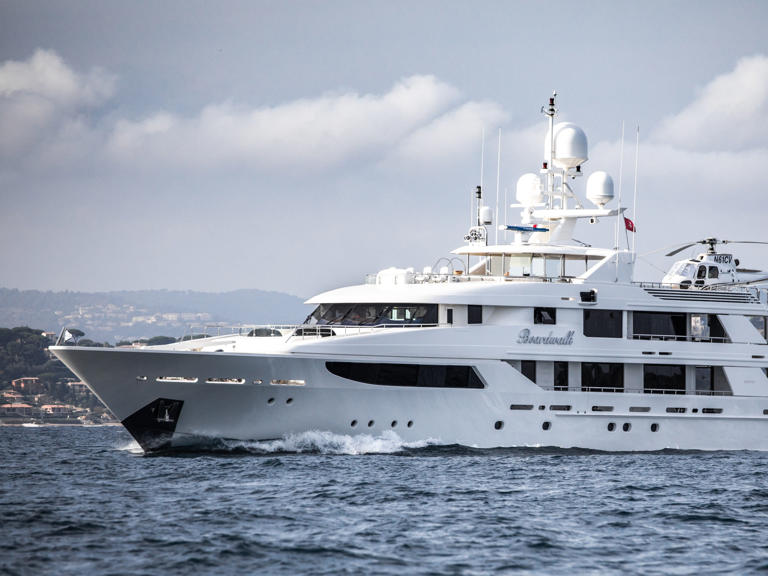
- Local Politics
- Nation & World Politics
A seized superyacht shows up in Everett — minus one Russian oligarch owner

EVERETT — It’s not clear whether Russian oligarch Suleiman Kerimov had plans to visit Puget Sound this spring — the French Riviera is more the style of the U.S.-sanctioned mining and energy multibillionaire.
But Monday morning, the Amadea, a 348-foot, $300 million-plus superyacht said to be owned by Kerimov, arrived in the Port of Everett to have some work done at a local shipyard.
A sleek, white shark of a ship with a knifelike bow, raked profile and quarters for 16 guests and 36 crew, Amadea swanned past Everett’s industrial waterfront with a tug escort and all the made-for-TV glamour of an international celebrity fugitive. Kerimov, of course, was not on board.
In 2022, Amadea (“God’s love” in Latin) was seized in Fiji at the request of U.S. authorities who claim Kerimov has enabled Russian aggression in Ukraine and Syria. Money laundering and conspiracy were also alleged.
At the time, the seizure was hailed as a warning to “every corrupt Russian oligarch that they cannot hide — not even in the remotest part of the world,” as a deputy U.S. attorney general put it in a press statement .
But as any boat owner in this boat-focused community will tell you , seizing a superyacht is one thing. Maintaining its value as an asset is another — especially when the asset is the size of a ferry and equipped with a theater, a gym, beauty salon, teak decks, 30-foot-long pool, helipad and twin 5,766-horsepower diesels.
“They’re saying it’s costing us $7 million a year to keep it up,” said Chris Petersen, a retired fisherman who runs a metal coatings shop on West Marine View Drive, a few blocks from the port and who, like many here, has been following the superyacht saga since Monday.
Indeed, fuel, maintenance, insurance and salary for the crew of Amadea during its impoundment in San Diego ran around $740,000 a month, according to federal court filings by the Marshals Service.
In February, the Justice Department told a federal court it intended to halt this “excessive … drain on the public” purse by auctioning off Amadea, which the government claims Kerimov acquired in 2021.
But selling off this excessive drain has been complicated.
There is litigation challenging Amadea’s seizure because the vessel allegedly wasn’t owned by Kerimov, but by another Russian oligarch, who is not sanctioned, according to court papers.
Another complication, more relevant to Everett: Amadea’s insurance policy, according to court filings, requires service that can only be done by hauling the vessel out of the water — a job that appears to be slated for the dry dock facilities at Everett Ship Repair, on the port’s East Waterway.
Few details of the project have been shared. Port officials have referred all questions to Everett Ship Repair, whose vice president of service sales, Lane Richards, politely declined to comment.
But a Justice Department spokesperson confirmed Thursday that Amadea was indeed “in Washington for standard dry dock maintenance.”
And on Wednesday, the vessel in question could be seen berthed, like a slightly lost Imperial Starship, on the south side of Pier 3, adjacent to Everett Ship Repair’s dry dock and the Washington State Ferry Salish.
All the no-commenting has only added to the atmosphere of maritime intrigue and speculation in a town ordinarily unperturbed by big, secrecy-shrouded ships, including those at the nearby Everett Naval Station.
Many here wonder why the U.S. government spent the money to bring Amadea all the way to Everett, when there are dry dock facilities in San Diego, San Francisco and Portland; even Seattle is 5 nautical miles closer to San Diego.
Amadea’s fuel burn “is probably in the 8-to-10 gallons per mile range,” said Dennis Butterfield, a retired car dealership manager and former boat owner, as he kept an eye on the Russian superyacht Wednesday from a viewpoint on Warren Avenue. “That’s the United States government at work, if you ask me.”
Butterfield’s estimate was close: based on vessel specifications featured on the yachting website, YachCharterFleet , the 4,400-ton Amadea burns roughly 11 gallons per mile at a cruising speed of 15 mph.
The Justice Department declined to justify Amadea’s four-day journey from San Diego to Everett.
Such secrecy would likely suit Kerimov, who Forbes once described as “one of the most private Russian billionaires,” and who is also said to have close ties to the government of Russian President Vladimir Putin. The 58-year-old serves in the Russian Federation Senate, is reportedly worth nearly $11 billion and has owned villas on the French Riviera and elsewhere.
Most Read Business Stories
- Whistleblower Josh Dean of Boeing supplier Spirit AeroSystems has died
- Seattle-founded REI struggles to adapt to changing retail. What’s next?
- Owner says King County appraiser pushed ‘tax advocacy’ side biz after boosting valuation
- The wild rise of Zillow Gone Wild VIEW
- Baby boomers have trillions squirreled away. Their kids may not see much of it
He may also have owned a rare Fabergé egg, according to accounts of the search of the Amadea after its seizure .
Beginning in 2017, Kerimov was listed by U.S. officials as one of a number of Russian oligarchs “who profit from the Russian government through corruption and its malign activity around the globe .”
In March 2022, after the FBI reportedly linked Kerimov to the Amadea , the vessel was seized under a program known as Task Force KleptoCapture and eventually sailed to San Diego under an American flag.
But Amadea’s more recent trip likely had less to do with the vessel’s checkered lineage than with a shortage of West Coast dry dock capacity, especially for large vessels.
Unlike the East Coast and the Gulf Coast, ship repair infrastructure on the West Coast is “is woefully undersized,” said Craig Hooper, a former naval ship building industry executive who writes and advises on security and defense issues.
In recent decades, several private shipyards with dry dock facilities have closed and building new capacity faces high costs and regulatory hurdles, Hooper said. As a result, “long transits to an open facility are relatively commonplace these days,” he added.
In the case of the Amadea, Hooper hypothesized, “the responsible party may have put the job out for bid and an Everett yard was the available, lowest-cost option.”
According to court filings, Amadea’s dry dock work is expected to cost $5.6 million and take two months.
By that time, federal officials may have sorted Amadea’s other complications.
Last fall, attorneys for Eduard Khudainatov, the former head of state-owed oil company Rosneft, claimed Amadea isn’t owned by Kerimov, but by Khudainatov. Attorneys argue that since Khudainatov wasn’t under sanctions, the yacht was “not forfeitable, as it neither constitutes nor is derived from any unlawful activity.”
But federal prosecutors contend “that Khudainatov is just a straw owner put forward to disguise Kerimov’s ownership of the vessel,” according to an April 19 filing in a federal court in New York, where the case is ongoing.
In the meantime, Everett will take some pleasure in the Amadea’s august presence.
Port of Everett officials, though tight lipped about the vessel’s particulars, were clearly pleased by the message it sends of the port’s growing status as a maritime hub.
“Anything that puts Everett on the international map is a good thing!” said Kate Anderson, port spokesperson, in an email response to an inquiry about the Amadea.
Locals, too, appeared to be enjoying the celebrity by association.
“That magnitude of wealth — it’s just another world,” said Petersen, the retired fisherman.
Others wondered who would be foolish enough to buy a vessel whose ownership was being contested by Russian oligarchs.
But mostly, folks here appeared to sympathize with Uncle Sam’s desire to be rid of the costly, controversial craft.
That was the sentiment of John Mostrom, who had taken a break from mowing his lawn Wednesday to peer down at the Amadea from the Warren Avenue overlook.
“They say the two happiest days of a boat owner’s life,” Mostrom noted, “are when they buy the boat and when they sell it.”
The opinions expressed in reader comments are those of the author only and do not reflect the opinions of The Seattle Times.
mark twain essay on german language
Mark twain's essay on german.
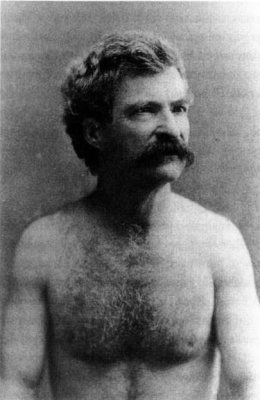
The Awful German Language
A little learning makes the whole world kin. -- Proverbs xxxii, 7.
I went often to look at the collection of curiosities in Heidelberg Castle, and one day I surprised the keeper of it with my German. I spoke entirely in that language. He was greatly interested; and after I had talked a while he said my German was very rare, possibly a "unique"; and wanted to add it to his museum.
Surely there is not another language that is so slipshod and systemless, and so slippery and elusive to the grasp. One is washed about in it, hither and thither, in the most helpless way; and when at last he thinks he has captured a rule which offers firm ground to take a rest on amid the general rage and turmoil of the ten parts of speech, he turns over the page and reads, "Let the pupil make careful note of the following exceptions ." He runs his eye down and finds that there are more exceptions to the rule than instances of it. So overboard he goes again, to hunt for another Ararat and find another quicksand. Such has been, and continues to be, my experience. Every time I think I have got one of these four confusing "cases" where I am master of it, a seemingly insignificant preposition intrudes itself into my sentence, clothed with an awful and unsuspected power, and crumbles the ground from under me. For instance, my book inquires after a certain bird -- (it is always inquiring after things which are of no sort of consequence to anybody): "Where is the bird?" Now the answer to this question -- according to the book -- is that the bird is waiting in the blacksmith shop on account of the rain. Of course no bird would do that, but then you must stick to the book. Very well, I begin to cipher out the German for that answer. I begin at the wrong end, necessarily, for that is the German idea. I say to myself, " Regen (rain) is masculine -- or maybe it is feminine -- or possibly neuter -- it is too much trouble to look now. Therefore, it is either der (the) Regen, or die (the) Regen, or das (the) Regen, according to which gender it may turn out to be when I look. In the interest of science, I will cipher it out on the hypothesis that it is masculine. Very well -- then the rain is der Regen, if it is simply in the quiescent state of being mentioned , without enlargement or discussion -- Nominative case; but if this rain is lying around, in a kind of a general way on the ground, it is then definitely located, it is doing something -- that is, resting (which is one of the German grammar's ideas of doing something), and this throws the rain into the Dative case, and makes it dem Regen. However, this rain is not resting, but is doing something actively , -- it is falling -- to interfere with the bird, likely -- and this indicates movement , which has the effect of sliding it into the Accusative case and changing dem Regen into den Regen." Having completed the grammatical horoscope of this matter, I answer up confidently and state in German that the bird is staying in the blacksmith shop "wegen (on account of) den Regen." Then the teacher lets me softly down with the remark that whenever the word "wegen" drops into a sentence, it always throws that subject into the Genitive case, regardless of consequences -- and that therefore this bird stayed in the blacksmith shop "wegen des Regens."
N. B. -- I was informed, later, by a higher authority, that there was an "exception" which permits one to say "wegen den Regen" in certain peculiar and complex circumstances, but that this exception is not extended to anything but rain.
There are ten parts of speech, and they are all troublesome. An average sentence, in a German newspaper, is a sublime and impressive curiosity; it occupies a quarter of a column; it contains all the ten parts of speech -- not in regular order, but mixed; it is built mainly of compound words constructed by the writer on the spot, and not to be found in any dictionary -- six or seven words compacted into one, without joint or seam -- that is, without hyphens; it treats of fourteen or fifteen different subjects, each inclosed in a parenthesis of its own, with here and there extra parentheses which reinclose three or four of the minor parentheses, making pens within pens: finally, all the parentheses and reparentheses are massed together between a couple of king-parentheses, one of which is placed in the first line of the majestic sentence and the other in the middle of the last line of it -- after which comes the VERB , and you find out for the first time what the man has been talking about; and after the verb -- merely by way of ornament, as far as I can make out -- the writer shovels in " haben sind gewesen gehabt haben geworden sein ," or words to that effect, and the monument is finished. I suppose that this closing hurrah is in the nature of the flourish to a man's signature -- not necessary, but pretty. German books are easy enough to read when you hold them before the looking-glass or stand on your head -- so as to reverse the construction -- but I think that to learn to read and understand a German newspaper is a thing which must always remain an impossibility to a foreigner.
Yet even the German books are not entirely free from attacks of the Parenthesis distemper -- though they are usually so mild as to cover only a few lines, and therefore when you at last get down to the verb it carries some meaning to your mind because you are able to remember a good deal of what has gone before. Now here is a sentence from a popular and excellent German novel -- which a slight parenthesis in it. I will make a perfectly literal translation, and throw in the parenthesis-marks and some hyphens for the assistance of the reader -- though in the original there are no parenthesis-marks or hyphens, and the reader is left to flounder through to the remote verb the best way he can:
"But when he, upon the street, the (in-satin-and-silk-covered-now-very-unconstrained-after-the-newest-fashioned-dressed) government counselor's wife met ," etc., etc. [1]
1. Wenn er aber auf der Strasse der in Sammt und Seide gehüllten jetzt sehr ungenirt nach der neusten Mode gekleideten Regierungsräthin begegnet.
That is from The Old Mamselle's Secret, by Mrs. Marlitt. And that sentence is constructed upon the most approved German model. You observe how far that verb is from the reader's base of operations; well, in a German newspaper they put their verb away over on the next page; and I have heard that sometimes after stringing along the exciting preliminaries and parentheses for a column or two, they get in a hurry and have to go to press without getting to the verb at all. Of course, then, the reader is left in a very exhausted and ignorant state.
We have the Parenthesis disease in our literature, too; and one may see cases of it every day in our books and newspapers: but with us it is the mark and sign of an unpracticed writer or a cloudy intellect, whereas with the Germans it is doubtless the mark and sign of a practiced pen and of the presence of that sort of luminous intellectual fog which stands for clearness among these people. For surely it is not clearness -- it necessarily can't be clearness. Even a jury would have penetration enough to discover that. A writer's ideas must be a good deal confused, a good deal out of line and sequence, when he starts out to say that a man met a counselor's wife in the street, and then right in the midst of this so simple undertaking halts these approaching people and makes them stand still until he jots down an inventory of the woman's dress. That is manifestly absurd. It reminds a person of those dentists who secure your instant and breathless interest in a tooth by taking a grip on it with the forceps, and then stand there and drawl through a tedious anecdote before they give the dreaded jerk. Parentheses in literature and dentistry are in bad taste.
The Germans have another kind of parenthesis, which they make by splitting a verb in two and putting half of it at the beginning of an exciting chapter and the other half at the end of it. Can any one conceive of anything more confusing than that? These things are called "separable verbs." The German grammar is blistered all over with separable verbs; and the wider the two portions of one of them are spread apart, the better the author of the crime is pleased with his performance. A favorite one is reiste ab -- which means departed. Here is an example which I culled from a novel and reduced to English:
"The trunks being now ready, he DE- after kissing his mother and sisters, and once more pressing to his bosom his adored Gretchen, who, dressed in simple white muslin, with a single tuberose in the ample folds of her rich brown hair, had tottered feebly down the stairs, still pale from the terror and excitement of the past evening, but longing to lay her poor aching head yet once again upon the breast of him whom she loved more dearly than life itself, PARTED ."
However, it is not well to dwell too much on the separable verbs. One is sure to lose his temper early; and if he sticks to the subject, and will not be warned, it will at last either soften his brain or petrify it. Personal pronouns and adjectives are a fruitful nuisance in this language, and should have been left out. For instance, the same sound, sie , means you , and it means she , and it means her , and it means it , and it means they , and it means them . Think of the ragged poverty of a language which has to make one word do the work of six -- and a poor little weak thing of only three letters at that. But mainly, think of the exasperation of never knowing which of these meanings the speaker is trying to convey. This explains why, whenever a person says sie to me, I generally try to kill him, if a stranger.
Now observe the Adjective. Here was a case where simplicity would have been an advantage; therefore, for no other reason, the inventor of this language complicated it all he could. When we wish to speak of our "good friend or friends," in our enlightened tongue, we stick to the one form and have no trouble or hard feeling about it; but with the German tongue it is different. When a German gets his hands on an adjective, he declines it, and keeps on declining it until the common sense is all declined out of it. It is as bad as Latin. He says, for instance:
- Nominative -- Mein gut er Freund, my good friend.
- Genitive -- Mein es gut en Freund es , of my good friend.
- Dative -- Mein em gut en Freund, to my good friend.
- Accusative -- Mein en gut en Freund, my good friend.
- N. -- Mein e gut en Freund e , my good friends.
- G. -- Mein er gut en Freund e , of my good friends.
- D. -- Mein en gut en Freund en , to my good friends.
- A. -- Mein e gut en Freund e , my good friends.
Now let the candidate for the asylum try to memorize those variations, and see how soon he will be elected. One might better go without friends in Germany than take all this trouble about them. I have shown what a bother it is to decline a good (male) friend; well this is only a third of the work, for there is a variety of new distortions of the adjective to be learned when the object is feminine, and still another when the object is neuter. Now there are more adjectives in this language than there are black cats in Switzerland, and they must all be as elaborately declined as the examples above suggested. Difficult? -- troublesome? -- these words cannot describe it. I heard a Californian student in Heidelberg say, in one of his calmest moods, that he would rather decline two drinks than one German adjective.
The inventor of the language seems to have taken pleasure in complicating it in every way he could think of. For instance, if one is casually referring to a house, Haus , or a horse, Pferd , or a dog, Hund , he spells these words as I have indicated; but if he is referring to them in the Dative case, he sticks on a foolish and unnecessary e and spells them Hause , Pferde , Hunde . So, as an added e often signifies the plural, as the s does with us, the new student is likely to go on for a month making twins out of a Dative dog before he discovers his mistake; and on the other hand, many a new student who could ill afford loss, has bought and paid for two dogs and only got one of them, because he ignorantly bought that dog in the Dative singular when he really supposed he was talking plural -- which left the law on the seller's side, of course, by the strict rules of grammar, and therefore a suit for recovery could not lie.
In German, all the Nouns begin with a capital letter. Now that is a good idea; and a good idea, in this language, is necessarily conspicuous from its lonesomeness. I consider this capitalizing of nouns a good idea, because by reason of it you are almost always able to tell a noun the minute you see it. You fall into error occasionally, because you mistake the name of a person for the name of a thing, and waste a good deal of time trying to dig a meaning out of it. German names almost always do mean something, and this helps to deceive the student. I translated a passage one day, which said that "the infuriated tigress broke loose and utterly ate up the unfortunate fir forest" ( Tannenwald ). When I was girding up my loins to doubt this, I found out that Tannenwald in this instance was a man's name.
Every noun has a gender, and there is no sense or system in the distribution; so the gender of each must be learned separately and by heart. There is no other way. To do this one has to have a memory like a memorandum-book. In German, a young lady has no sex, while a turnip has. Think what overwrought reverence that shows for the turnip, and what callous disrespect for the girl. See how it looks in print -- I translate this from a conversation in one of the best of the German Sunday-school books:
To continue with the German genders: a tree is male, its buds are female, its leaves are neuter; horses are sexless, dogs are male, cats are female -- tomcats included, of course; a person's mouth, neck, bosom, elbows, fingers, nails, feet, and body are of the male sex, and his head is male or neuter according to the word selected to signify it, and not according to the sex of the individual who wears it -- for in Germany all the women either male heads or sexless ones; a person's nose, lips, shoulders, breast, hands, and toes are of the female sex; and his hair, ears, eyes, chin, legs, knees, heart, and conscience haven't any sex at all. The inventor of the language probably got what he knew about a conscience from hearsay.
Now, by the above dissection, the reader will see that in Germany a man may think he is a man, but when he comes to look into the matter closely, he is bound to have his doubts; he finds that in sober truth he is a most ridiculous mixture; and if he ends by trying to comfort himself with the thought that he can at least depend on a third of this mess as being manly and masculine, the humiliating second thought will quickly remind him that in this respect he is no better off than any woman or cow in the land.
In the German it is true that by some oversight of the inventor of the language, a Woman is a female; but a Wife ( Weib ) is not -- which is unfortunate. A Wife, here, has no sex; she is neuter; so, according to the grammar, a fish is he , his scales are she , but a fishwife is neither. To describe a wife as sexless may be called under-description; that is bad enough, but over-description is surely worse. A German speaks of an Englishman as the Engländer ; to change the sex, he adds inn , and that stands for Englishwoman -- Engländerinn . That seems descriptive enough, but still it is not exact enough for a German; so he precedes the word with that article which indicates that the creature to follow is feminine, and writes it down thus: " die Engländer inn ," -- which means "the she-Englishwoman ." I consider that that person is over-described.
Well, after the student has learned the sex of a great number of nouns, he is still in a difficulty, because he finds it impossible to persuade his tongue to refer to things as " he " and " she ," and " him " and " her ," which it has been always accustomed to refer to it as " it ." When he even frames a German sentence in his mind, with the hims and hers in the right places, and then works up his courage to the utterance-point, it is no use -- the moment he begins to speak his tongue flies the track and all those labored males and females come out as " it s." And even when he is reading German to himself, he always calls those things " it ," where as he ought to read in this way:
The Tale of the fishwife and its sad fate
2. I capitalize the nouns, in the German (and ancient English) fashion.
It is a bleak Day. Hear the Rain, how he pours, and the Hail, how he rattles; and see the Snow, how he drifts along, and of the Mud, how deep he is! Ah the poor Fishwife, it is stuck fast in the Mire; it has dropped its Basket of Fishes; and its Hands have been cut by the Scales as it seized some of the falling Creatures; and one Scale has even got into its Eye, and it cannot get her out. It opens its Mouth to cry for Help; but if any Sound comes out of him, alas he is drowned by the raging of the Storm. And now a Tomcat has got one of the Fishes and she will surely escape with him. No, she bites off a Fin, she holds her in her Mouth -- will she swallow her? No, the Fishwife's brave Mother-dog deserts his Puppies and rescues the Fin -- which he eats, himself, as his Reward. O, horror, the Lightning has struck the Fish-basket; he sets him on Fire; see the Flame, how she licks the doomed Utensil with her red and angry Tongue; now she attacks the helpless Fishwife's Foot -- she burns him up, all but the big Toe, and even she is partly consumed; and still she spreads, still she waves her fiery Tongues; she attacks the Fishwife's Leg and destroys it ; she attacks its Hand and destroys her also; she attacks the Fishwife's Leg and destroys her also; she attacks its Body and consumes him ; she wreathes herself about its Heart and it is consumed; next about its Breast, and in a Moment she is a Cinder; now she reaches its Neck -- he goes; now its Chin -- it goes; now its Nose -- she goes. In another Moment, except Help come, the Fishwife will be no more. Time presses -- is there none to succor and save? Yes! Joy, joy, with flying Feet the she-Englishwoman comes! But alas, the generous she-Female is too late: where now is the fated Fishwife? It has ceased from its Sufferings, it has gone to a better Land; all that is left of it for its loved Ones to lament over, is this poor smoldering Ash-heap. Ah, woeful, woeful Ash-heap! Let us take him up tenderly, reverently, upon the lowly Shovel, and bear him to his long Rest, with the Prayer that when he rises again it will be a Realm where he will have one good square responsible Sex, and have it all to himself, instead of having a mangy lot of assorted Sexes scattered all over him in Spots.
There, now, the reader can see for himself that this pronoun business is a very awkward thing for the unaccustomed tongue. I suppose that in all languages the similarities of look and sound between words which have no similarity in meaning are a fruitful source of perplexity to the foreigner. It is so in our tongue, and it is notably the case in the German. Now there is that troublesome word vermählt : to me it has so close a resemblance -- either real or fancied -- to three or four other words, that I never know whether it means despised, painted, suspected, or married; until I look in the dictionary, and then I find it means the latter. There are lots of such words and they are a great torment. To increase the difficulty there are words which seem to resemble each other, and yet do not; but they make just as much trouble as if they did. For instance, there is the word vermiethen (to let, to lease, to hire); and the word verheirathen (another way of saying to marry). I heard of an Englishman who knocked at a man's door in Heidelberg and proposed, in the best German he could command, to "verheirathen" that house. Then there are some words which mean one thing when you emphasize the first syllable, but mean something very different if you throw the emphasis on the last syllable. For instance, there is a word which means a runaway, or the act of glancing through a book, according to the placing of the emphasis; and another word which signifies to associate with a man, or to avoid him, according to where you put the emphasis -- and you can generally depend on putting it in the wrong place and getting into trouble.
There are some exceedingly useful words in this language. Schlag , for example; and Zug . There are three-quarters of a column of Schlag s in the dictionary, and a column and a half of Zug s. The word Schlag means Blow, Stroke, Dash, Hit, Shock, Clap, Slap, Time, Bar, Coin, Stamp, Kind, Sort, Manner, Way, Apoplexy, Wood-cutting, Enclosure, Field, Forest-clearing. This is its simple and exact meaning -- that is to say, its restricted, its fettered meaning; but there are ways by which you can set it free, so that it can soar away, as on the wings of the morning, and never be at rest. You can hang any word you please to its tail, and make it mean anything you want to. You can begin with Schlag-ader , which means artery, and you can hang on the whole dictionary, word by word, clear through the alphabet to Schlag-wasser , which means bilge-water -- and including Schlag-mutter , which means mother-in-law.
Just the same with Zug . Strictly speaking, Zug means Pull, Tug, Draught, Procession, March, Progress, Flight, Direction, Expedition, Train, Caravan, Passage, Stroke, Touch, Line, Flourish, Trait of Character, Feature, Lineament, Chess-move, Organ-stop, Team, Whiff, Bias, Drawer, Propensity, Inhalation, Disposition: but that thing which it does not mean -- when all its legitimate pennants have been hung on, has not been discovered yet.
One cannot overestimate the usefulness of Schlag and Zug . Armed just with these two, and the word also , what cannot the foreigner on German soil accomplish? The German word also is the equivalent of the English phrase "You know," and does not mean anything at all -- in talk , though it sometimes does in print. Every time a German opens his mouth an also falls out; and every time he shuts it he bites one in two that was trying to get out.
Now, the foreigner, equipped with these three noble words, is master of the situation. Let him talk right along, fearlessly; let him pour his indifferent German forth, and when he lacks for a word, let him heave a Schlag into the vacuum; all the chances are that it fits it like a plug, but if it doesn't let him promptly heave a Zug after it; the two together can hardly fail to bung the hole; but if, by a miracle, they should fail, let him simply say also ! and this will give him a moment's chance to think of the needful word. In Germany, when you load your conversational gun it is always best to throw in a Schlag or two and a Zug or two, because it doesn't make any difference how much the rest of the charge may scatter, you are bound to bag something with them . Then you blandly say also , and load up again. Nothing gives such an air of grace and elegance and unconstraint to a German or an English conversation as to scatter it full of "Also's" or "You knows."
In my note-book I find this entry:
July 1 . -- In the hospital yesterday, a word of thirteen syllables was successfully removed from a patient -- a North German from near Hamburg; but as most unfortunately the surgeons had opened him in the wrong place, under the impression that he contained a panorama, he died. The sad event has cast a gloom over the whole community.
That paragraph furnishes a text for a few remarks about one of the most curious and notable features of my subject -- the length of German words. Some German words are so long that they have a perspective. Observe these examples:
- Freundschaftsbezeigungen.
- Dilettantenaufdringlichkeiten.
- Stadtverordnetenversammlungen.
These things are not words, they are alphabetical processions. And they are not rare; one can open a German newspaper at any time and see them marching majestically across the page -- and if he has any imagination he can see the banners and hear the music, too. They impart a martial thrill to the meekest subject. I take a great interest in these curiosities. Whenever I come across a good one, I stuff it and put it in my museum. In this way I have made quite a valuable collection. When I get duplicates, I exchange with other collectors, and thus increase the variety of my stock. Here are some specimens which I lately bought at an auction sale of the effects of a bankrupt bric-a-brac hunter:
- Generalstaatsverordnetenversammlungen.
- Alterthumswissenschaften.
- Kinderbewahrungsanstalten.
- Unabhaengigkeitserklaerungen.
- Wiedererstellungbestrebungen.
- Waffenstillstandsunterhandlungen.
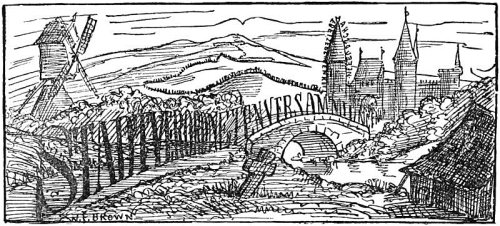
Of course when one of these grand mountain ranges goes stretching across the printed page, it adorns and ennobles that literary landscape -- but at the same time it is a great distress to the new student, for it blocks up his way; he cannot crawl under it, or climb over it, or tunnel through it. So he resorts to the dictionary for help, but there is no help there. The dictionary must draw the line somewhere -- so it leaves this sort of words out. And it is right, because these long things are hardly legitimate words, but are rather combinations of words, and the inventor of them ought to have been killed. They are compound words with the hyphens left out. The various words used in building them are in the dictionary, but in a very scattered condition; so you can hunt the materials out, one by one, and get at the meaning at last, but it is a tedious and harassing business. I have tried this process upon some of the above examples. " Freundschaftsbezeigungen " seems to be "Friendship demonstrations," which is only a foolish and clumsy way of saying "demonstrations of friendship." " Unabhaengigkeitserklaerungen " seems to be "Independencedeclarations," which is no improvement upon "Declarations of Independence," so far as I can see. " Generalstaatsverordnetenversammlungen " seems to be "General-statesrepresentativesmeetings," as nearly as I can get at it -- a mere rhythmical, gushy euphuism for "meetings of the legislature," I judge. We used to have a good deal of this sort of crime in our literature, but it has gone out now. We used to speak of a things as a "never-to-be-forgotten" circumstance, instead of cramping it into the simple and sufficient word "memorable" and then going calmly about our business as if nothing had happened. In those days we were not content to embalm the thing and bury it decently, we wanted to build a monument over it.
But in our newspapers the compounding-disease lingers a little to the present day, but with the hyphens left out, in the German fashion. This is the shape it takes: instead of saying "Mr. Simmons, clerk of the county and district courts, was in town yesterday," the new form put it thus: "Clerk of the County and District Courts Simmons was in town yesterday." This saves neither time nor ink, and has an awkward sound besides. One often sees a remark like this in our papers: " Mrs. Assistant District Attorney Johnson returned to her city residence yesterday for the season." That is a case of really unjustifiable compounding; because it not only saves no time or trouble, but confers a title on Mrs. Johnson which she has no right to. But these little instances are trifles indeed, contrasted with the ponderous and dismal German system of piling jumbled compounds together. I wish to submit the following local item, from a Mannheim journal, by way of illustration:
"In the daybeforeyesterdayshortlyaftereleveno'clock Night, the inthistownstandingtavern called `The Wagoner' was downburnt. When the fire to the onthedownburninghouseresting Stork's Nest reached, flew the parent Storks away. But when the bytheraging, firesurrounded Nest itself caught Fire, straightway plunged the quickreturning Mother-stork into the Flames and died, her Wings over her young ones outspread."
Even the cumbersome German construction is not able to take the pathos out of that picture -- indeed, it somehow seems to strengthen it. This item is dated away back yonder months ago. I could have used it sooner, but I was waiting to hear from the Father-stork. I am still waiting.
" Also !" If I had not shown that the German is a difficult language, I have at least intended to do so. I have heard of an American student who was asked how he was getting along with his German, and who answered promptly: "I am not getting along at all. I have worked at it hard for three level months, and all I have got to show for it is one solitary German phrase -- ` Zwei Glas '" (two glasses of beer). He paused for a moment, reflectively; then added with feeling: "But I've got that solid !"
And if I have not also shown that German is a harassing and infuriating study, my execution has been at fault, and not my intent. I heard lately of a worn and sorely tried American student who used to fly to a certain German word for relief when he could bear up under his aggravations no longer -- the only word whose sound was sweet and precious to his ear and healing to his lacerated spirit. This was the word Damit . It was only the sound that helped him, not the meaning; [3] and so, at last, when he learned that the emphasis was not on the first syllable, his only stay and support was gone, and he faded away and died.
3. It merely means, in its general sense, "herewith."
I think that a description of any loud, stirring, tumultuous episode must be tamer in German than in English. Our descriptive words of this character have such a deep, strong, resonant sound, while their German equivalents do seem so thin and mild and energyless. Boom, burst, crash, roar, storm, bellow, blow, thunder, explosion; howl, cry, shout, yell, groan; battle, hell. These are magnificent words; the have a force and magnitude of sound befitting the things which they describe. But their German equivalents would be ever so nice to sing the children to sleep with, or else my awe-inspiring ears were made for display and not for superior usefulness in analyzing sounds. Would any man want to die in a battle which was called by so tame a term as a Schlacht ? Or would not a consumptive feel too much bundled up, who was about to go out, in a shirt-collar and a seal-ring, into a storm which the bird-song word Gewitter was employed to describe? And observe the strongest of the several German equivalents for explosion -- Ausbruch . Our word Toothbrush is more powerful than that. It seems to me that the Germans could do worse than import it into their language to describe particularly tremendous explosions with. The German word for hell -- Hölle -- sounds more like helly than anything else; therefore, how necessary chipper, frivolous, and unimpressive it is. If a man were told in German to go there, could he really rise to thee dignity of feeling insulted?
Having pointed out, in detail, the several vices of this language, I now come to the brief and pleasant task of pointing out its virtues. The capitalizing of the nouns I have already mentioned. But far before this virtue stands another -- that of spelling a word according to the sound of it. After one short lesson in the alphabet, the student can tell how any German word is pronounced without having to ask; whereas in our language if a student should inquire of us, "What does B, O, W, spell?" we should be obliged to reply, "Nobody can tell what it spells when you set if off by itself; you can only tell by referring to the context and finding out what it signifies -- whether it is a thing to shoot arrows with, or a nod of one's head, or the forward end of a boat."
There are some German words which are singularly and powerfully effective. For instance, those which describe lowly, peaceful, and affectionate home life; those which deal with love, in any and all forms, from mere kindly feeling and honest good will toward the passing stranger, clear up to courtship; those which deal with outdoor Nature, in its softest and loveliest aspects -- with meadows and forests, and birds and flowers, the fragrance and sunshine of summer, and the moonlight of peaceful winter nights; in a word, those which deal with any and all forms of rest, repose, and peace; those also which deal with the creatures and marvels of fairyland; and lastly and chiefly, in those words which express pathos, is the language surpassingly rich and affective. There are German songs which can make a stranger to the language cry. That shows that the sound of the words is correct -- it interprets the meanings with truth and with exactness; and so the ear is informed, and through the ear, the heart.
The Germans do not seem to be afraid to repeat a word when it is the right one. they repeat it several times, if they choose. That is wise. But in English, when we have used a word a couple of times in a paragraph, we imagine we are growing tautological, and so we are weak enough to exchange it for some other word which only approximates exactness, to escape what we wrongly fancy is a greater blemish. Repetition may be bad, but surely inexactness is worse.
There are people in the world who will take a great deal of trouble to point out the faults in a religion or a language, and then go blandly about their business without suggesting any remedy. I am not that kind of person. I have shown that the German language needs reforming. Very well, I am ready to reform it. At least I am ready to make the proper suggestions. Such a course as this might be immodest in another; but I have devoted upward of nine full weeks, first and last, to a careful and critical study of this tongue, and thus have acquired a confidence in my ability to reform it which no mere superficial culture could have conferred upon me.
In the first place, I would leave out the Dative case. It confuses the plurals; and, besides, nobody ever knows when he is in the Dative case, except he discover it by accident -- and then he does not know when or where it was that he got into it, or how long he has been in it, or how he is going to get out of it again. The Dative case is but an ornamental folly -- it is better to discard it.
In the next place, I would move the Verb further up to the front. You may load up with ever so good a Verb, but I notice that you never really bring down a subject with it at the present German range -- you only cripple it. So I insist that this important part of speech should be brought forward to a position where it may be easily seen with the naked eye.
Thirdly, I would import some strong words from the English tongue -- to swear with, and also to use in describing all sorts of vigorous things in a vigorous ways.
4. "Verdammt," and its variations and enlargements, are words which have plenty of meaning, but the sounds are so mild and ineffectual that German ladies can use them without sin. German ladies who could not be induced to commit a sin by any persuasion or compulsion, promptly rip out one of these harmless little words when they tear their dresses or don't like the soup. It sounds about as wicked as our "My gracious." German ladies are constantly saying, "Ach! Gott!" "Mein Gott!" "Gott in Himmel!" "Herr Gott" "Der Herr Jesus!" etc. They think our ladies have the same custom, perhaps; for I once heard a gentle and lovely old German lady say to a sweet young American girl: "The two languages are so alike -- how pleasant that is; we say `Ach! Gott!' you say `Goddamn.'"
Fourthly, I would reorganize the sexes, and distribute them accordingly to the will of the creator. This as a tribute of respect, if nothing else.
Fifthly, I would do away with those great long compounded words; or require the speaker to deliver them in sections, with intermissions for refreshments. To wholly do away with them would be best, for ideas are more easily received and digested when they come one at a time than when they come in bulk. Intellectual food is like any other; it is pleasanter and more beneficial to take it with a spoon than with a shovel.
Sixthly, I would require a speaker to stop when he is done, and not hang a string of those useless " haben sind gewesen gehabt haben geworden sein s" to the end of his oration. This sort of gewgaws undignify a speech, instead of adding a grace. They are, therefore, an offense, and should be discarded.
Seventhly, I would discard the Parenthesis. Also the reparenthesis, the re-reparenthesis, and the re-re-re-re-re-reparentheses, and likewise the final wide-reaching all-inclosing king-parenthesis. I would require every individual, be he high or low, to unfold a plain straightforward tale, or else coil it and sit on it and hold his peace. Infractions of this law should be punishable with death.
And eighthly, and last, I would retain Zug and Schlag , with their pendants, and discard the rest of the vocabulary. This would simplify the language.
I have now named what I regard as the most necessary and important changes. These are perhaps all I could be expected to name for nothing; but there are other suggestions which I can and will make in case my proposed application shall result in my being formally employed by the government in the work of reforming the language.
My philological studies have satisfied me that a gifted person ought to learn English (barring spelling and pronouncing) in thirty hours, French in thirty days, and German in thirty years. It seems manifest, then, that the latter tongue ought to be trimmed down and repaired. If it is to remain as it is, it ought to be gently and reverently set aside among the dead languages, for only the dead have time to learn it.
A Fourth of July Oration in the German Tongue, Delivered at a Banquet of the Anglo-American Club of Students by the Author of This Book
Gentlemen: Since I arrived, a month ago, in this old wonderland, this vast garden of Germany, my English tongue has so often proved a useless piece of baggage to me, and so troublesome to carry around, in a country where they haven't the checking system for luggage, that I finally set to work, and learned the German language. Also! Es freut mich dass dies so ist, denn es muss, in ein hauptsächlich degree, höflich sein, dass man auf ein occasion like this, sein Rede in die Sprache des Landes worin he boards, aussprechen soll. Dafür habe ich, aus reinische Verlegenheit -- no, Vergangenheit -- no, I mean Höflichkeit -- aus reinische Höflichkeit habe ich resolved to tackle this business in the German language, um Gottes willen! Also! Sie müssen so freundlich sein, und verzeih mich die interlarding von ein oder zwei Englischer Worte, hie und da, denn ich finde dass die deutsche is not a very copious language, and so when you've really got anything to say, you've got to draw on a language that can stand the strain.
Wenn haber man kann nicht meinem Rede Verstehen, so werde ich ihm später dasselbe übersetz, wenn er solche Dienst verlangen wollen haben werden sollen sein hätte. (I don't know what "wollen haben werden sollen sein hätte" means, but I notice they always put it at the end of a German sentence -- merely for general literary gorgeousness, I suppose.)
This is a great and justly honored day -- a day which is worthy of the veneration in which it is held by the true patriots of all climes and nationalities -- a day which offers a fruitful theme for thought and speech; und meinem Freunde -- no, mein en Freund en -- mein es Freund es -- well, take your choice, they're all the same price; I don't know which one is right -- also! ich habe gehabt haben worden gewesen sein, as Goethe says in his Paradise Lost -- ich -- ich -- that is to say -- ich -- but let us change cars.
Do you like this site? Get the guidebook!

Destination Munich
Want to learn more about German/Bavarian culture and traditions?
• Go to the main Munich Backstory page. • Jump from Mark Twain's Essay on German back to Destination Munich Home
Readers' faves
- The web's best overview of the Munich Oktoberfest.
- Details of the beer tents, dates, times, FAQs, photos and plenty more.
- Oktoberfest songs
- My new sister site dedicated to the Music of Oktoberfest. Slur along to the most popular tunes - with German and English lyrics, and videos.
- Munich for kids
- Got the little ones along? Here's how to keep them busy.
- Eating out with kids in Munich guide to - 10 places parents won't want to miss
- Munich webcams
- See what's happening around town RIGHT NOW!
- Surfing Munich
- Riding the brakers in a landlocked city - you'll love this! One of the crazier things to do in Munich.
What's fresh
- The crazy ice-cream maker
- This great ice-cream cafe has flavours inclduding white sausage, Oktoberfest beer and pregnancy test.
- Munich Documentation Centre for the History of National Socialism
- A place to learn about and remember Germany's Nazi past.
- The top 10 tourist attractions in Munich
- What are the must-sees on a break to Munich? Don't miss these gems.
- 20 Facts on Germany
- Think you know Germany? Here are 20 fast facts about the powerhouse of Europe.
- German Dirndl Get the backstory behind the dress that launched a thousands hips.
- Kaltenberg Knights Tournament
- Europe's biggest middle-ages festival, coming this summer.
- Cheap Munich - 10 money saving travel tips
- Ideas for a cheap Munich visit.
- Top of page
- Comments? Questions?
- Privacy Policy
- About the author
- What's new on the site
- Worldwide travel sites
- Munich magazine
Which Language Do You Want to Learn?
- Inside Babbel
- Babbel Bytes
ARTICLES ABOUT
The awful german language, revisited.

Illustration by Chaim Garcia
Dear Mr Twain,
I can’t tell you how much I enjoyed your essay, The Awful German Language . It hit home not only because of its humor and accuracy, but because I embarked on a similarly painful voyage of discovery as that which you describe. When I started learning German a few years ago in a cramped Berlin classroom, my most frequent question was, “Why?”
Why do we need four cases for our nouns? Why do verbs sometimes split in two and run away from each other? Why do adjectives need to be declined? To this day, if I may quote you, I “would rather decline two drinks than one German adjective.”
Well, Mr Twain, you have been dead for over a century now, so maybe it’s about time to have another look at your marvelous essay and see if anything has changed in the intervening years.
Most of your suggestions for how to slim German down into a more manageable tongue have been ignored. I regret to inform you that the Dative case is well and truly alive, and in fact it is the Genitive case — the one which adds the sneaky S to its nouns as in wegen des Regens, “because of the rain” — which seems most under threat. In some dialects it’s being replaced by a clunky Dative form.
Your recommendations to move the verb up to the front, reorganize the sexes according to the will of the creator, and do away with long compound words, have largely gone unheeded. Not that they aren’t good ideas in principle, but the first would allow people to interrupt each other in the middle of arguments, the second would cause a lot of arguments, and the third would remove most of the best words to use in arguments.
There have been a few improvements over the last century that you would appreciate. Those confusing Ss that look like Fs, which I imagine were still around when you were learning German, are only seen behind the glass cases of museum cabinets and in second hand bookstores. There have been several useful Rechtschreibreformen , or spelling reforms . German spelling is almost perfectly phonetic; what you see is what you get. I can quite confidently read long passages from Kafka, the meaning of which I am completely and utterly ignorant. It’s a great party trick if you’re at the right sort of party.
The Germans continue to capitalize their nouns, which, frankly, is the least they could do. There’s still some confusion over capitalizing pronouns, like Du / du and Sie / sie , but it’s only a matter of time until a verdict is reached.
But noun cases are exactly as they were when you were writing over 130 years ago, and for anyone without prior experience they are as fresh, painful and tricky as you describe. I am still haunted by the difference between Accusative and Dative. Even to this day, my eyes will occasionally glaze over mid-sentence and you can be fairly sure I’m either wondering if I left the iron on or worrying about noun cases.
Not to mention the adjectives that precede them. For a while, I just tried to leave out all adjectives while speaking:
“See that car over there?” “Which one?” “Yes.”
Part of the problem with learning German is figuring out what order to put the words in. A good rule of thumb is if it feels backwards and strange, it’s probably correct. It’s a bit like trying to organize the contents of a briefcase while cycling down a steep slope: you’re trying to apply the brakes and fit everything in before the verb arrives like an oncoming car. Heaven help you if it’s a separable verb, one of those that splits in two and hides at opposite ends of the sentence. “Only a German is so discourteous to his verbs” was how your contemporary from the other side of the pond Sir Arthur Conan Doyle put it.
Your claim that “to learn to read and understand a German newspaper is a thing which must always remain an impossibility to a foreigner,” is, happily, no longer true. Nowadays there’s no need to slog through the cerebral ones like Die Zeit and Der Spiegel. Why bother when you can immerse yourself in Bild Zeitung, which has short sentences and lots of pictures of football players and scantily-clad women.
Academic writing on the other hand frequently features sentences that last a paragraph, or a page, depending on how much intellectual posturing the writer felt compelled to exhibit on that particular day.
Your attachment to Schlag and Zug should also be updated. Modern German fillers include doch , mal , bloß , denn , eben , schon , ja , halt and eigentlich . Don’t ask me what they mean, just sprinkle your speech liberally with them. If in doubt, throw in a vielleicht and a wohl . I also would thoroughly recommend genau , “exactly”: I’ve seen non-German speakers have half-hour-long telephone conversations using only this word.
You can also add super and mega to any almost any adjective. Go on, try it.
One final observation, Mark (may I call you Mark?). Your essay is full of the awfulness of German, focusing on the remarkable difficulties and curves that lie ahead for the poor unsuspecting learner. And yet, is there a slight, coy affection behind all that snarkiness? For all your complaints, I can’t help but think that in spite of all the difficulties – or maybe because of them – you are really quite fond of German.
But that can be our little secret.
Read Twain’s full essay, The Awful German Language , here.
We will keep fighting for all libraries - stand with us!
Internet Archive Audio

- This Just In
- Grateful Dead
- Old Time Radio
- 78 RPMs and Cylinder Recordings
- Audio Books & Poetry
- Computers, Technology and Science
- Music, Arts & Culture
- News & Public Affairs
- Spirituality & Religion
- Radio News Archive

- Flickr Commons
- Occupy Wall Street Flickr
- NASA Images
- Solar System Collection
- Ames Research Center

- All Software
- Old School Emulation
- MS-DOS Games
- Historical Software
- Classic PC Games
- Software Library
- Kodi Archive and Support File
- Vintage Software
- CD-ROM Software
- CD-ROM Software Library
- Software Sites
- Tucows Software Library
- Shareware CD-ROMs
- Software Capsules Compilation
- CD-ROM Images
- ZX Spectrum
- DOOM Level CD

- Smithsonian Libraries
- FEDLINK (US)
- Lincoln Collection
- American Libraries
- Canadian Libraries
- Universal Library
- Project Gutenberg
- Children's Library
- Biodiversity Heritage Library
- Books by Language
- Additional Collections

- Prelinger Archives
- Democracy Now!
- Occupy Wall Street
- TV NSA Clip Library
- Animation & Cartoons
- Arts & Music
- Computers & Technology
- Cultural & Academic Films
- Ephemeral Films
- Sports Videos
- Videogame Videos
- Youth Media
Search the history of over 866 billion web pages on the Internet.
Mobile Apps
- Wayback Machine (iOS)
- Wayback Machine (Android)
Browser Extensions
Archive-it subscription.
- Explore the Collections
- Build Collections
Save Page Now
Capture a web page as it appears now for use as a trusted citation in the future.
Please enter a valid web address
- Donate Donate icon An illustration of a heart shape
Audio with external links item preview.

Share or Embed This Item
Flag this item for.
- Graphic Violence
- Explicit Sexual Content
- Hate Speech
- Misinformation/Disinformation
- Marketing/Phishing/Advertising
- Misleading/Inaccurate/Missing Metadata

plus-circle Add Review comment Reviews
62,076 Views
5 Favorites
DOWNLOAD OPTIONS
In collections.
Uploaded by librivoxbooks on June 12, 2011
SIMILAR ITEMS (based on metadata)
This audio reading of The Awful German Language is read by
- 20595-01.mp3
- 20595-01.ogg
- 20595-01.m4b
- 20595-01.spx
- 20595-02.mp3
- 20595-02.ogg
- 20595-02.m4b
- 20595-02.spx
- 20595-03.mp3
- 20595-03.ogg
- 20595-03.m4b
- 20595-03.spx

Librivox Audio Recording Public Domain Certification:
The person or persons who have associated work with this document (the "Dedicator" or "Certifier") hereby either (a) certifies that, to the best of his knowledge, the work of authorship identified is in the public domain of the country from which the work is published, or (b) hereby dedicates whatever copyright the dedicators holds in the work of authorship identified below (the "Work") to the public domain. A certifier, moreover, dedicates any copyright interest he may have in the associated work, and for these purposes, is described as a "dedicator" below.
A certifier has taken reasonable steps to verify the copyright status of this work. Certifier recognizes that his good faith efforts may not shield him from liability if in fact the work certified is not in the public domain.
Dedicator makes this dedication for the benefit of the public at large and to the detriment of the Dedicator's heirs and successors. Dedicator intends this dedication to be an overt act of relinquishment in perpetuity of all present and future rights under copyright law, whether vested or contingent, in the Work. Dedicator understands that such relinquishment of all rights includes the relinquishment of all rights to enforce (by lawsuit or otherwise) those copyrights in the Work.
Dedicator recognizes that, once placed in the public domain, the Work may be freely reproduced, distributed, transmitted, used, modified, built upon, or otherwise exploited by anyone for any purpose, commercial or non-commercial, and in any way, including by methods that have not yet been invented or conceived.
Audio formats available:
128kbit MP3 - MP3 subfolder 64kbit Ogg Vorbis (variable bit rate) - OGG subfolder Apple AAC audiobook (16kbit mono) - M4B subfolder Speex - SPX subfolder

The Horrors of the German Language
Die Schrecken der deutschen Sprache Address to the Vienna Press Club, November 21, 1897.
It has me deeply touched, my gentlemen, here so hospitably received to be. From colleagues out of my own profession, in this from my own home so far distant land. My heart is full of gratitude, but my poverty of German words forces me to greater economy of expression. Excuse you, my gentlemen, that I read off, what I you say will.
The German language speak I not good, but have numerous connoisseurs me assured that I her write like an angel. Maybe—maybe—I know not. Have till now no acquaintance with the angels had. That comes later—when it the dear God please—it has no hurry.
Since long, my gentlemen, have I the passionate longing nursed a speech on German to hold, but one has me not permitted. Men, who no feeling for the art had, laid me ever hindrance in the way and made naught my desire—sometimes by excuses, often by force. Always said these men to me: “Keep you still, your Highness! Silence! For God’s sake seek another way and means yourself obnoxious to make.”
In the present case, as usual it is me difficult become, for me the permission to obtain. The committee sorrowed deeply, but could me the permission not grant on account of a law which from the Concordia demands she shall the German language protect. Du liebe Zeit! How so had one to me this say could—might—dared—should? I am indeed the truest friend of the German language—and not only now, but from long since—yes, before twenty years already. And never have I the desire had the noble language to hurt; to the contrary, only wished she to improve—I would her only reform. It is the dream of my life been. I have already visits by the various German governments paid and for contracts prayed. I am now to Austria in the same task come. I would only some changes effect. I would only the language method—the luxurious, elaborate construction compress, the eternal parenthesis suppress, do away with, annihilate; the introduction of more than thirteen subjects in one sentence forbid; the verb so far to the front pull that one it without a telescope discover can. With one word, my gentlemen, I would your beloved language simplify so that, my gentlemen, when you her for prayer need, One her yonder-up understands.
I beseech you, from me yourself counsel to let, execute these mentioned reforms. Then will you an elegant language possess, and afterward, when you some thing say will, will you at least yourself understand what you said had. But often nowadays, when you a mile-long sentence from you given and you yourself somewhat have rested, then must you have a touching inquisitiveness have yourself to determine what you actually spoken have. Before several days has the correspondent of a local paper a sentence constructed which hundred and twelve words contain, and therein were seven parentheses smuggled in, and the subject seven times changed. Think you only, my gentlemen, in the course of the voyage of a single sentence must the poor, persecuted, fatigued subject seven times change position!
Now, when we the mentioned reforms execute, will it no longer so bad be. Doch noch eins. I might gladly the separable verb also a little bit reform. I might none do let what Schiller did: he has the whole history of the Thirty Years’ War between the two members of a separable verb in-pushed. That has even Germany itself aroused, and one has Schiller the permission refused the History of the Hundred Years’ War to compose—God be it thanked! After all these reforms established be will, will the German language the noblest and the prettiest on the world be.
Since to you now, my gentlemen, the character of my mission known is, beseech I you so friendly to be and to me your valuable help grant. Mr. Potzl has the public believed make would that I to Vienna come am in order the bridges to clog up and the traffic to hinder, while I observations gather and note. Allow you yourselves but not from him deceived. My frequent presence on the bridges has an entirely innocent ground. Yonder gives it the necessary space, yonder can one a noble long German sentence elaborate, the bridge-railing along, and his whole contents with one glance overlook. On the one end of the railing pasted I the first member of a separable verb and the final member cleave I to the other end—then spread the body of the sentence between it out! Usually are for my purposes the bridges of the city long enough; when I but Potzl’s writings study will I ride out and use the glorious endless imperial bridge. But this is a calumny; Potzl writes the prettiest German. Perhaps not so pliable as the mine, but in many details much better. Excuse you these flatteries. These are well deserved.
Now I my speech execute—no, I would say I bring her to the close. I am a foreigner—but here, under you, have I it entirely forgotten. And so again and yet again proffer I you my heartiest thanks.
Twain wrote this speech in excellent German, and is said to have delivered it without reading (contrary to what he says in the first paragraph)
Other works by Mark Twain...
At that time, in Kentucky (said the Hon. Mr. K- - - - ); the law was very strict against what is termed “games of chance.” About a dozen of the boys were detected playing “seven up” or ...
February 22. To-day is the great Birth-Day; and it was observed so widely in the earth that differences in longitudinal time made curious work with some of the cabled testimonies of res...
q|The editor of the Memphis Avalanche swoops thus mildly down upon a correspondent who posted him as a Radical:—"While he was writing the first word, the middle, dotting his i’s, crossi...
At General G——'s reception the other night, the most fashionably dressed lady was Mrs. G. C. She wore a pink satin dress, plain in front but with a good deal of rake to it—to the train,...
I had never seen him before. He brought letters of introduction from mutual friends in San Francisco, and by invitation I breakfasted with him. It was almost religion, there in the silv...
In a recent issue of the “Independent,” the Rev. T. De Witt Talmage, of Brooklyn, has the following utterance on the subject of “Smells”: I have a good Christian friend who, if he sat i...
Sir,—I am approaching seventy; it is in sight; it is only three years away. Necessarily, I must go soon. It is but matter-of-course wisdom, then, that I should begin to set my worldly h...
Thirty-five years ago I was out prospecting on the Stanislaus, tramping all day long with pick and pan and horn, and washing a hatful of dirt here and there, always expecting to make a ...
[The following letter, signed by Satan and purporting to come from him, we have reason to believe was not written by him, but by Mark Twain.—Editor.] Dear Sir and Kinsman,—Let us have d...
“I was sitting here,” said the judge, “in this old pulpit, holding court, and we were trying a big, wicked-looking Spanish desperado for killing the husband of a bright, pretty Mexican ...
He arrives just as regularly as the clock strikes nine in the morning. And so he even beats the editor sometimes, and the porter must leave his work and climb two or three pairs of stai...

It is a good many years since I was in Switzerland last. In that remote time there was only one ladder railway in the country. That state of things is all changed. There isn’t ...
As I passed along by one of those monster American tea stores in New York, I found a Chinaman sitting before it acting in the capacity of a sign. Everybody that passed by gave him a ste...
[AT A FOURTH OF JULY GATHERING, IN LONDON, OF AMERICANS] MR. CHAIRMAN AND LADIES AND GENTLEMEN: I thank you for the compliment which has just been tendered me, and to show my appreciati...
IN ENGLISH. THEN IN FRENCH. THEN CLAWED BACK INTO A CIVILIZED LANGUAGE ONCE MORE BY PATIENT, UNREMUNERATED TOIL. Even a criminal is entitled to fair play; and certainly when a man w...

- What's New!
- Dictionaries
- German Translator 101
- Better Translation
- Buying Translation
- Culture & Translation
- Translation Challenges
- Machine Translation
- Best Business Software
- Translation Software
- Online Resources
- Getting Started
- Translation Courses
- Translators Associations
- Meet A Translator!
- My Translation Services
- Culture & Translation
- Awful German Language
Awful German Language!
Was Mark Twain right?
“The Awful German Language”, much maligned by Mark Twain, is spoken by almost 200 million people worldwide and is, according to Wikipedia, the 3rd most learned language worldwide.
This page is intended as a humorous plea on behalf of the German language!
Mark Twain does have a point!
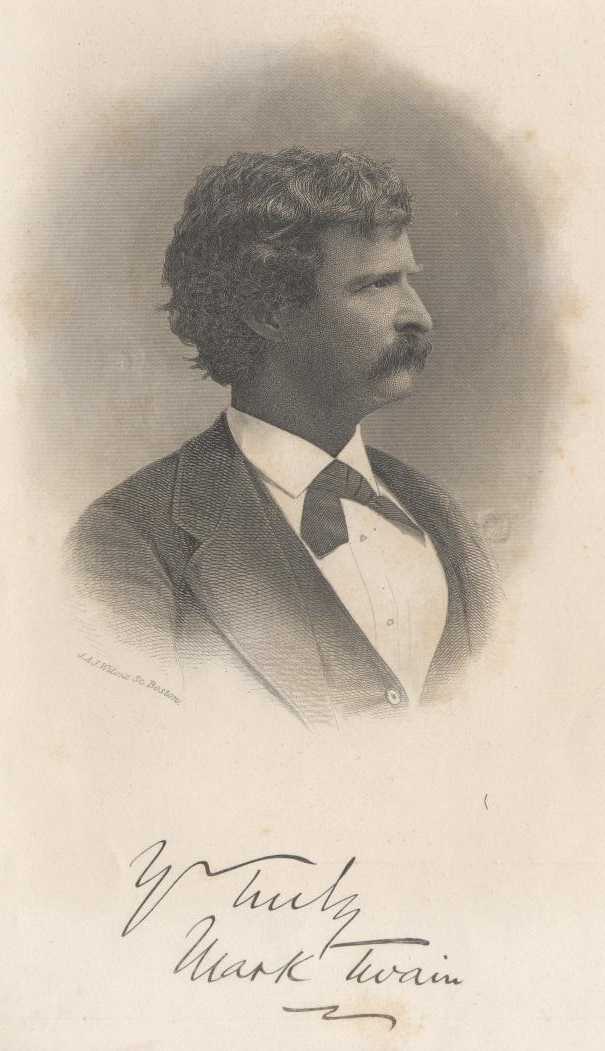
In “The Awful German Language", the 19th Century American writer Mark Twain presents a collection of satirical observations about the German language in the form of a short essay.
Dated 1880, Twain recounts his travels through Germany, Switzerland and France with his travelling companion Harris, in which he takes on the persona of an American tourist fighting with the vagaries of the German language.
Tongue in cheek, it remains an amusing take on the German language from the view of a foreigner – lessons for us all!
“Some German words are so long that they have a perspective"
"Observe these examples: Freundschaftsbezeigungen - demonstrations of friendship Dilettantenaufdringlichkeiten - the importunities of dilettantes Stadtverordnetenversammlungen - meetings of the legislature
These things are not words, they are alphabetical processions. And they are not rare; one can open a German newspaper at any time and see them marching majestically across the page....” Appendix D of A Tramp Abroad, “That Awful German Language”
On learning the awful German language

"My philological studies have satisfied me that a gifted person ought to learn English (barring spelling and pronouncing) in thirty hours, French in thirty days, and German in thirty years.
It seems manifest, then, that the latter tongue ought to be trimmed down and repaired.
If it is to remain as it is, it ought to be gently and reverently set aside among the dead languages, for only the dead have time to learn it.“ Appendix D of A Tramp Abroad, “That Awful German Language”
On the position of German verbs
“Whenever the literary German dives into a sentence, that is the last you are going to see of him till he emerges on the other side of this Atlantic with his verb in his mouth.” A Connecticut Yankee in King Arthur’s Court
“The Germans have an inhuman way of cutting up their verbs. Now a verb has a hard time enough of it in this world when it’s all together. It’s downright inhuman to split it up.
But that’s just what those Germans do.
They take part of a verb and put it down here, like a stake, and they take the other part of it and put it away over yonder like another stake, and between these two limits they just shovel in German.” Mark Twain’s speeches, “Disappearance of Literature”
And finally, on the treatment of German nouns...
“In German, a young lady has no sex, while a turnip has. Think what overwrought reverence that shows for the turnip, and what callous disrespect for the girl.
See how it looks in print -- I translate this from a conversation in one of the best of the German Sunday-school books: Gretchen: Wilhelm, where is the turnip? Wilhelm: She has gone to the kitchen. Gretchen: Where is the accomplished and beautiful English maiden? Wilhelm: It has gone to the opera.
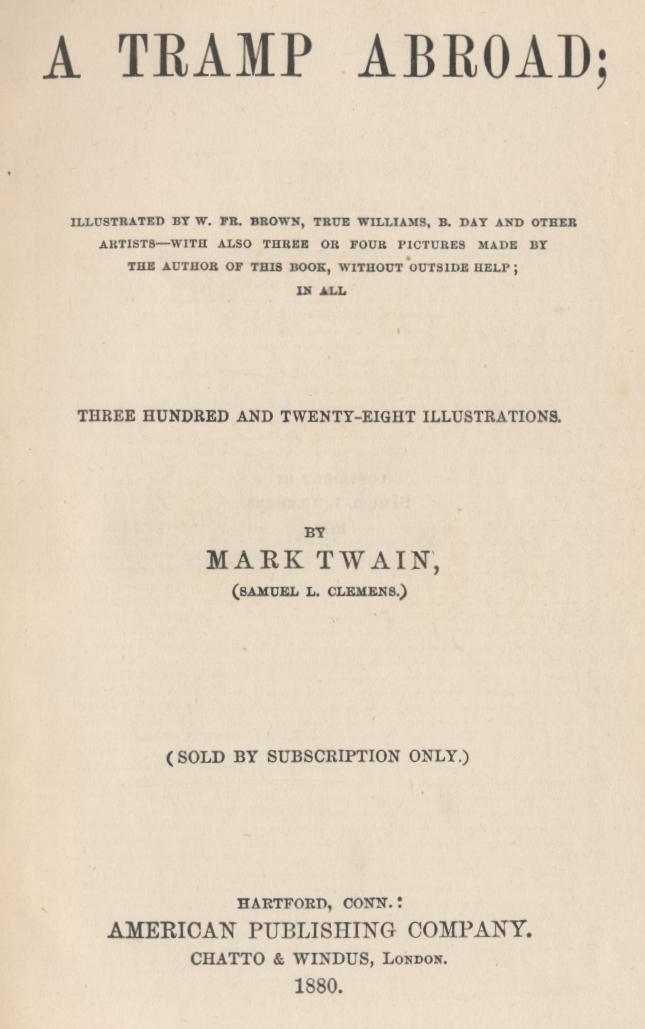
To continue with the German genders: a tree is male, its buds are female, its leaves are neuter; horses are sexless, dogs are male, cats are female -- tomcats included, of course; a person's mouth, neck, bosom, elbows, fingers, nails, feet, and body are of the male sex, and his head is male or neuter according to the word selected to signify it, and not according to the sex of the individual who wears it... Now, by the above dissection, the reader will see that in Germany a man may think he is a man, but when he comes to look into the matter closely, he is bound to have his doubts; he finds that in sober truth he is a most ridiculous mixture; and if he ends by trying to comfort himself with the thought that he can at least depend on a third of this mess as being manly and masculine, the humiliating second thought will quickly remind him that in this respect he is no better off than any woman or cow in the land.”
Appendix D of A Tramp Abroad, “That Awful German Language”
Mark Twain’s knowledge of the German language was obviously profound - yet the Gentleman doth protest too much, me thinks!
He even lectured to German speaking audiences on the dreadful nature of the German language!
If you’re interested in reading more about what Mark Twain has to say about the “awful German language”, then download the original text from that wonderful source of copyright free online literature, the Project Gutenberg .
And in the meantime, take heart dear students of German, this “awful German language” could very well lead you to a great career in German translation !
Happy translating,
Joanna
German Translation Tips & Resources
Disclosure : If you buy from a link below I get a small commission. There is no extra charge to you.
You may also like...
German sms language, your insider guide.
Trying to understand German SMS language? Desperate to decipher those SMS abbreviations of everyday German phrases? Help is here!

Oktoberfest in Germany - Auf geht's zur Wiesn!
Join us for a linguistic tour of Oktoberfest in Germany! A rich selection of German expressions and terms and real insight into the culture of Germany.

German Holidays, A Calendar of Key Dates
A list of the official German holidays and major holidays in Germany, Austria and Switzerland, plus their English equivalents and translations.

Joanna Scudamore-Trezek
I'm a German to English translator living and working in Vienna, Austria. I turn German texts into clear and accessible English, allowing clients to present their stories, ideas and information to a completely new audience. My business and marketing clients rely on me to get their message across clearly and effectively. How can I help you today?
Would you prefer to share this page with others by linking to it?
- Click on the HTML link code below.
- Copy and paste it, adding a note of your own, into your blog, a Web page, forums, a blog comment, your Facebook account, or anywhere that someone would find this page valuable.
Disclosure : A s an Amazon Associate I earn from qualifying purchases . More details here.
Essential resources

Recent Articles
Oct 03, 23 04:08 AM
Meet Certified Translation Service Provider Berlin Translate
Dec 07, 22 03:14 AM

Dec 06, 22 11:40 AM
What visitors Say
"I just want to send you a small note with a big 'thank you' attached for your amazing website and all the advice and information you offer - for free!" Caroline, Germany
"Liebe Joanna, ich möchte dir ganz herzlich für die vielen nützlichen Informationen danken. Es ist extrem hilfreich. Vielen, vielen Dank!" Silke, Germany
"It's really great to see a website dedicated to the translation of only a single language. There are too many general websites around on the web." Roshni, India "Thanks, your website is really helpful to read about advice on getting started as a German translator....very grateful!" Georgie, UK "Ich bin auf deine Webseite gestoßen und finde die Seite super. Informativ, lebendiger Schreibstill. Danke für deine inspirierende Seite! Beste Grüße!" Feng, China
Tell us what you think!
Essential reading

Got a question?
Something you want to ask about German translation? Check out the Q&As or Ask Me!
Copyright © 2024, germantranslationtips.om, All rights reserved.
Click here to review our Disclaimer (Impressum), Privacy Policy, and Affiliate Disclosure . As an Amazon Associate I earn from qualifying purchases. Search for content using our Sitemap , and feel free to get in touch using this contact form .
Graphic Arts
Exhibitions, acquisitions, and other highlights from the graphic arts collection, princeton university library.

Twain expanded on this with an essay that became a wonderful lecture titled Die Schrecken der deutschen Sprache ( The Horrors of the German Language ), which Twain was often called on to repeat.

German artist and printer Eckhard Froeschlin, who runs Edition Schwarze Seite, was inspired by Twain to create a contemporary fine press edition entitled An Awful German Language (2018), recently acquired by the Graphic Arts Collection. http://www.froeschlin-edition.de/seiten/ed_buecher/2018_TWAIN.pdf
“I heard a Californian student in Heidelberg,” writes Frieschlin, “say, in one of his calmest moods, that he would rather decline two drinks than one German adjective.“ Twain’s text appears in excerpts, accompanied by mezzotint etchings, which Froeschlin created while traveling in California and New England. Bet his English was perfect.
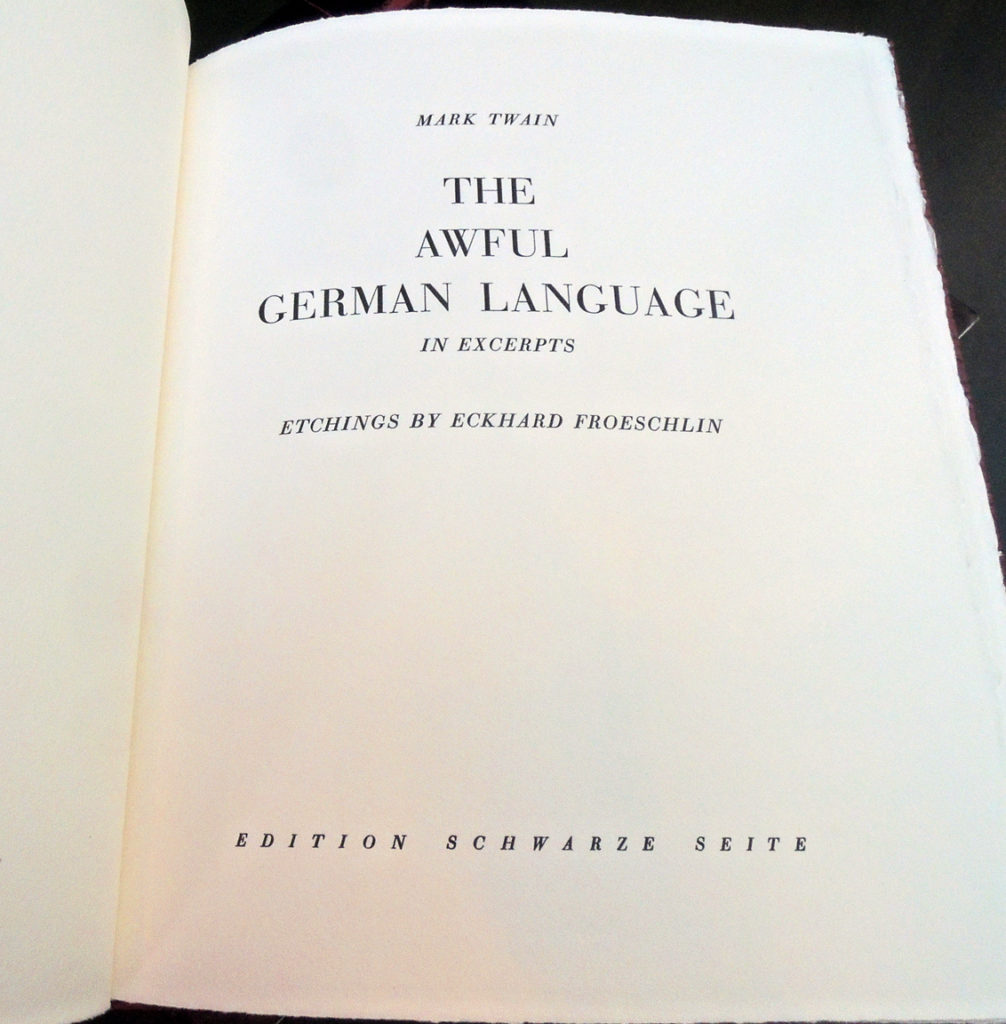
Mark Twain – The Awful German Language

The Awful German Language – Mark Twain
The Awful German Language is an essay by the American author Mark Twain in which he humorously outlines the complexity of the language and the difficulties he encountered while learning it. It is a must-read book for students of the often baffling German language.
Twain, most famous for his Huckleberry Finn stories, travelled extensively through Europe in 1878 and wrote about his experiences, especially in Germany in A Tramp Abroad, which was published in 1880. The Awful German Language is Appendix D of that book and is full of insightful observations.
From the moment I arrived in Berlin learning German has been one of my main priorities and has at times seemed like an impossible task. Like Twain, I have had many moments when I’ve felt like I was getting to grips with the language only to find myself mere hours later feeling like I had no idea what I was hearing or reading.
Anyone who has attempted to learn the language – and anyone who lives in and loves Berlin has hopefully at least tried – will appreciate the difficulties that Twain recounts.
Describing the intricacies of German grammar rules he writes:
…and when at last he thinks he has found a rule which offers firm ground to take a rest on amid the general rage and turmoil of the ten parts of speech, he turns over the page and reads, “Let the pupil make careful note of the following EXCEPTIONS”. He then runs his eye down and finds that there are more exceptions to the rule than instances of it.
He also sums up perfectly the problem I have using ‘er’ and ‘sie’ for objects I think of as ‘it’ – it doesn’t matter for instance that I know it is ‘der Tisch’, I somehow can’t persuade my brain to call ‘it’ a ‘he’.
Well, after the student has learned the sex of a great number of nouns, he is still in a difficulty, because he finds it impossible to persuade his tongue to refer to things as “he” and “she” and “him” and “her”, which it has been always accustomed to refer to as “it”. When he even frames a German sentence in his mind, with the hims and hers in the right places, and then works up his courage to the utterance-point, it is no use – the moment he begins to speak his tongue flies the track and all those laboured males and females come out as “its”.
Twain’s assessment of the complexity of the language and the time it takes to learn it offers at least a glimmer of hope for those struggling to come to terms with der, die, das and all their Akkusativ, Dativ and Genitiv variations though.
My philological studies have satisfied me that a gifted person ought to learn English (barring spelling and pronouncing) in thirty hours, French in thirty days, and German in thirty years.
For all his complaints and the impression he gives with the title ‘The Awful German Language’ it is clear that Mark Twain had a good understanding of and appreciation for German grammar and was most likely an accomplished linguist.
Swapping the Mississippi for the Spree, Twain returned to Berlin in October 1891 and spent the winter living in the city. His admiration is clear in his description of the German capital in his account of that time, The Chicago of Europe.
…all of Berlin is stately and substantial, and it is not merely in parts but uniformly beautiful.
If you’d like to read The Awful German Language, and if you’re learning German you really should, there are many print and digital versions of the essay available – I managed to get hold of it for free on Kindle in this version of Mark Twain’s ‘A Tramp Abroad’ compendium.
- tweet
- share
You might be interested in

Berlin , Book , Mark Twain , The Awful German Language
No comments yet.
Leave a reply click here to cancel reply..
Name (required)
Email (will not be published) (required)
By using this form you agree with the storage and handling of your data by this website. / Mit der Nutzung dieses Formulars erklärst du dich mit der Speicherung und Verarbeitung deiner Daten durch diese Website einverstanden. *
From a tramp abroad.

- < Previous
Home > ARTSCI > ML > ML_FACPUBS > 14
Modern and Classical Languages and Literatures Faculty Publications
Mark Twain and "The Awful German Language"
Norbert Hedderich , University of Rhode Island Follow
Document Type
Date of original version.
The article analyses Mark Twain's 1869 essay "The Awful German Language" in terms of Twain's comments on morphological, syntactical, lexical and phonological feature of German. The topic is presented in the context of Twain's German language learning experience. Relevance of the article for German language instruction today is also discussed.
Citation/Publisher Attribution
Hedderich, Norbert. "Mark Twain and "The Awful German Language"." Die Unterrichtspraxis / Teaching German 36, no. 1 (2003): 28-33. doi:10.2307/3531681. JSTOR , www.jstor.org/stable/3531681.
Since July 25, 2019
https://doi.org/10.2307/3531681
Author Manuscript
This is a pre-publication author manuscript of the final, published article.
Terms of Use
All rights reserved under copyright.
Advanced Search
- Notify me via email or RSS
- Collections
- Disciplines
Author Corner
- Submit Research
OA icon designed by Jafri Ali and dedicated to the public domain, CC0 1.0.
All other icons designed by Adrien Coquet and licensed under CC BY 4.0.
Home | About | FAQ | My Account | Accessibility Statement
Privacy Copyright
The 10 Wittiest Essays By Mark Twain

An American author and humorist, Mark Twain is known for his witty works, which include books, essays, short stories, speeches, and more. While not every single piece of written work was infused with humor, many were, ranging from deadpan humor to laugh-out-loud funny. We’ve put together a list, in no particular order, of ten witty pieces that will give you a peek inside the wittiness of this celebrated author.

As anyone who has ever learned or attempted to learn a second language knows, it is difficult and can be very frustrating at times. Twain explores this in the witty essay ‘ The Awful German Language ,’ which was first published in Appendix D in A Tramp Abroad. He describes the language as ‘perplexing’ with its ten different parts of speech, one sound meaning several different things, super long words, which he believes have their own ‘perspective,’ and so on. After breaking down the language, Twain goes on to describe how he would ‘reform it.’ When it comes to these long compound words, for example, he would ‘require the speaker to deliver them in sections, with intermissions for refreshments.’
How to Tell a Story
Advice to youth.
‘Always obey your parents…,’ is first piece of ‘advice’ Twain gives in his satirical essay ‘ Advice To Youth ,’ written in 1882; however, he immediately follows it with ‘…when they are present.’ He also discusses respecting superiors, but if they offend in any way, then the youth may ‘simply watch your chance and hit him with a brick.’ Other pieces of ‘advice’ from Twain include ‘be very careful about lying’ and ‘never handle firearms carelessly.’ He writes of books and how ‘Robertson’s Sermons, Baxter’s Saints’ Rest… ‘ are some of the books that the youth should read ‘exclusively.’ Twain was making a social commentary about the people of his time, but it is a fun read.

Become a Culture Tripper!
Sign up to our newsletter to save up to 500$ on our unique trips..
See privacy policy .

Taming the Bicycle
‘ Taming the Bicycle ‘ is a funny account of Twain learning to ride an old high wheel bike. This piece, while never published during his lifetime as he was never happy with it, is laugh-out-loud funny. Taking lessons from ‘the Expert,’ Twain has much difficulty learning to stay on the bike. Indeed, ‘He [the Expert] said that dismounting was perhaps the hardest thing to learn… But he was in error there.’ Hilarity ensues as Twain falls, repeatedly, on his teacher as he has trouble staying the bike for any amount of time. Eventually, Twain does learn how to get on the bike and dismount properly; he even writes ‘Get a bicycle. You will not regret it, if you live.’
Fenimore Cooper’s Literary Offences
Professionals once described Fenimore Cooper’s The Deerslayer and The Pathfinder as ‘artistic creations’ and Cooper himself as ‘the greatest artist in the domain of romantic fictions.’ In ‘ Fenimore Cooper’s Literary Offences ,’ Mark Twain clearly thought otherwise. In this critical essay, Twain states that Cooper violated 18 of the ‘rules governing literary art’ and proceeds to explain each one. Some of the funnier moments or rules broken include ‘1. That a tale shall accomplish something and arrive somewhere. But the Deerslayer tale accomplishes nothing and arrives in the air’ and ’12. Say what he is proposing to say, not merely come near it.’ This piece is biting and funny at the same time.
At the Funeral
While funerals are serious, Mark Twain manages to make the subject funny in ‘ At the Funeral ,’ a short essay in which the humorous writer gives his take on proper etiquette when attending such an event. For example, the attendee must not ‘criticise the person in whose honor the entertainment is given’ and definitely ‘make no remarks about his equipment.’ Also, the attendee should only ‘be moved…according to the degree of your intimacy’ with the people hosting the funeral or the deceased. And lastly, as only Twain would point out, ‘Do not bring your dog.’
On Theft and Conscience
‘On Theft and Conscience’ is an except taken from a speech Twain gave in 1902 and is printed in Mark Twain’s Helpful Hints for Good Living: A Handbook for the Damned Human Race . He recalled the first time he ‘removed’ (stole) a watermelon from a wagon; once he looked at it, he realized it was not yet ripe. He had a bit of remorse, so he returned the watermelon to the owner. This is Mark Twain after all; therefore, he told the owner ‘to reform.’ The owner, in turn, gave Twain a ripe melon, and Twain ‘forgave’ the owner.

The Jumping Frog
In 1865, Mark Twain wrote ‘The Celebrated Jumping Frog of Calaveras County,’ a witty short story about a gambler named Jim Smiley as told by the bartender, Sam Wheeler. A French writer, while liking the story and thinking it was funny, didn’t understand why it would cause anyone to laugh and translated the story into French in order prove his point. Twain caught wind of it and translated it back into English but using the grammatical structure and syntax of the French language. As he points out, ‘the Frenchman has riddled the grammar. I think it is the worst I ever saw…’ He published everything as ‘ The Jumping Frog : In English. Then in French. Then Clawed Back into a Civilized Language Once More By Patient, Unremunerated Toil.’
A Presidential Candidate
A satirical essay written in 1879, ‘A Presidential Candidate’ makes fun of the campaign process and explores the ideal candidate or in Twain’s words ‘a candidate who cannot be injured by investigation of his past history…’ If the candidate did, indeed, expose all his ‘wickedness’ then his opponents could not use his past against him. A truly witty piece, some of the secrets revealed include the candidate burying his deceased aunt under his grapevines because ‘the vine needed fertilizing, my aunt had to be buried, and I dedicated her to this high purpose’ and his dislike for ‘the poor man.’
Advice to Little Girls
While it is a funny short story, ‘ Advice to Little Girls ‘ also has deeper meaning: girls should think for themselves. For example, one piece of ‘advice’ Twain shares is ‘If you mother tells you to do a thing, it is wrong to reply that you won’t.’ He writes that little girls should act as they will do what they’re told but that ‘afterward act quietly in the matter according to the dictates of your best judgment.’ This piece also has recommendations on how take chewing gum from little brothers, how to treat friends who have better toys, plus several more little gems.

KEEN TO EXPLORE THE WORLD?
Connect with like-minded people on our premium trips curated by local insiders and with care for the world
Since you are here, we would like to share our vision for the future of travel - and the direction Culture Trip is moving in.
Culture Trip launched in 2011 with a simple yet passionate mission: to inspire people to go beyond their boundaries and experience what makes a place, its people and its culture special and meaningful — and this is still in our DNA today. We are proud that, for more than a decade, millions like you have trusted our award-winning recommendations by people who deeply understand what makes certain places and communities so special.
Increasingly we believe the world needs more meaningful, real-life connections between curious travellers keen to explore the world in a more responsible way. That is why we have intensively curated a collection of premium small-group trips as an invitation to meet and connect with new, like-minded people for once-in-a-lifetime experiences in three categories: Culture Trips, Rail Trips and Private Trips. Our Trips are suitable for both solo travelers, couples and friends who want to explore the world together.
Culture Trips are deeply immersive 5 to 16 days itineraries, that combine authentic local experiences, exciting activities and 4-5* accommodation to look forward to at the end of each day. Our Rail Trips are our most planet-friendly itineraries that invite you to take the scenic route, relax whilst getting under the skin of a destination. Our Private Trips are fully tailored itineraries, curated by our Travel Experts specifically for you, your friends or your family.
We know that many of you worry about the environmental impact of travel and are looking for ways of expanding horizons in ways that do minimal harm - and may even bring benefits. We are committed to go as far as possible in curating our trips with care for the planet. That is why all of our trips are flightless in destination, fully carbon offset - and we have ambitious plans to be net zero in the very near future.

Places to Stay
The best hotels to book in springfield, missouri.

The Best Cabins and Lodges to Book in Missouri, USA

The Best Hotels to Book Near the Gateway Arch, St Louis

The Best Hotels to Book in Missouri

The Best Places to Go Camping in Missouri, USA

Guides & Tips
The best things to do in st. louis.

Where to Find the Best Fall Foliage in Missouri

Food & Drink
Meet ashley shelton: the trailblazing chef putting st. louis on the culinary map.

The Fascinating History of the Haunted Lemp Mansion

Film & TV
7 celebrities you didn’t know were from missouri.

The Most Adventurous Activities in Missouri

See & Do
The 7 best vacation spots in missouri for families.
- Post ID: 417521
- Sponsored? No
- View Payload

A bare-chested Mark Twain with a crazy glint in his eye. Samuel Langhorne Clemens, better known to you and me as Mark Twain, also threw himself into die schöne deutsche Sprache. Twain's essays about his struggles with the language are hilarious and ring just as true today as they did when first published in his 1880 travel journal A Tramp ...
The Awful German Language. " The Awful German Language " is an 1880 essay by Mark Twain published as Appendix D in A Tramp Abroad. [1] The essay is a humorous exploration of the frustrations a native speaker of English has with learning German as a second language.
Mark Twain: The Horrors of the German Language / Die Schrecken der deutschen Sprache Address to the Vienna Press Club, November 21, 1897, Twain wrote this speech in excellent German, and is said to have delivered it without reading (contrary to what he says in the first paragraph). He also wrote the amusingly literal translation that you see below.
The Essay. The essay "The Awful German Language", published as Appendix D. in a A Tramp Abroad in 1879, is the product of Twain's first German. period. Despite later references about German in his notes and letters the essay remains his single most important comment on the subject.
the German language" (Cracroft 10). The German language occupied a strong international position at the time. It was the language of "science, litera-ture and erudition" (Cracroft 14). The humor of the essay lies not only in its tone, endless hyperbole, and irony, but also in Twain's organizational tech-nique. In addition to all the mockery, he ...
The Awful German Language, Revisited. In 1880 Mark Twain wrote the now infamous essay, "The Awful German Language", an account of his frustrations with the German language. It's about time we update his marvelous essay and see what has changed in the intervening years. By James Lane. January 13, 2016. Illustration by Chaim Garcia. Dear Mr ...
255 by Mark Twain. The Awful German Language by Mark Twain. No cover available. Read now or download (free!) Choose how to read this book Url Size; ... The Awful German Language Language: English: LoC Class: PS: Language and Literatures: American and Canadian literature: Subject: American wit and humor Subject: German language -- Humor
English. LibriVox recording of The Awful German Language, by Mark Twain. Read by Kirsten Wever. This long essay is a work of mock philology, one of several appendices to Twain's travel novel, A Tramp Abroad. In it, Twain explains, complains about, and shows how one might improve upon various aspects of the (awful) German language.
The Awful German Language Mark Twain. This audio reading of The Awful German Language is read by. Rainer. Contents. Part 1 - 00:15:53 20595-01.mp3; 20595-01.ogg
In 1953, Dr. John T. Krumpelmann collected the most thorough listing of Twain's various experiences with and attempts at German in his essay "Mark Twain and the German Language." Unfortunately, most of Krumpelmann' s sources for Twain's works, letters, and notebook entries were edited by Twain's "official" biographer Albert Bigelow Paine, who ...
The Horrors of the German Language. Address to the Vienna Press Club, November 21, 1897. It has me deeply touched, my gentlemen, here so hospitably received to be. From colleagues out of my own profession, in this from my own home so far distant land. My heart is full of gratitude, but my poverty of German words forces me to greater economy of ...
Mark Twain does have a point! In "The Awful German Language", the 19th Century American writer Mark Twain presents a collection of satirical observations about the German language in the form of a short essay. Dated 1880, Twain recounts his travels through Germany, Switzerland and France with his travelling companion Harris, in which he takes ...
Twain expanded on this with an essay that became a wonderful lecture titled Die Schrecken der deutschen Sprache (The Horrors of the German Language), which Twain was often called on to repeat. German artist and printer Eckhard Froeschlin, who runs Edition Schwarze Seite, was inspired by Twain to create a contemporary fine press edition entitled ...
Books. The Awful German Language. Mark Twain. BVK, May 15, 1880 - Humor - 38 pages. " The Awful German Language " is a humorous examination of the German language and the frustrations a native English speaker may have when learning it. The essay was published as Appendix D of " A Tramp Abroad " by Mark Twain in 1880.
The Awful German Language is an essay by the American author Mark Twain in which he humorously outlines the complexity of the language and the difficulties he encountered while learning it. It is a must-read book for students of the often baffling German language. Twain, most famous for his Huckleberry Finn stories, travelled extensively ...
The Awful German Language. The Awful German Language. Mark Twain. from A Tramp Abroad. A little learning makes the whole world kin. --Proverbs xxxii, 7. I went often to look at the collection of curiosities in Heidelberg Castle, and one day I surprised the keeper of it with my German. I spoke entirely in that language.
Analyzes Mark Twain's 1869 essay "The Awful German Language" in terms of Twain's comments on morphological, syntactical, lexical, and phonological features of German. The topic is presented in the context of Twain's German language learning experience. Relevance of the article for German language instruction today is also described. (Author/VWL)
The Awful German Language by Mark Twain A little learning makes the whole world kin. -- Proverbs xxxii, 7. I went often to look at the collection of curiosities in Heidelberg Castle, and one day I surprised the keeper of it with my German. I spoke entirely in that language. He was greatly interested; and after
essary, but pretty. German books are easy enough to read when you hold them before the looking-glass or stand on your head—so as to reverse the construc-tion—but I think that to learn to read and under-stand a German newspaper is a thing which must always remain an impossibility to a foreigner. Yet even the German books are not entirely free
MARK TWAIN JOURNAL, 31:1 (SPRING 1993) societies, singing societies and militia companies, the city had a variety of German language theaters.4 More important for the topic at hand is the existence of German language newspapers. One of these was the Anzeiger des Westens , which was started as a weekly newspaper in 1835. Four years
The article analyses Mark Twain's 1869 essay "The Awful German Language" in terms of Twain's comments on morphological, syntactical, lexical and phonological feature of German. The topic is presented in the context of Twain's German language learning experience. Relevance of the article for German language instruction today is also discussed.
Twain explores this in the witty essay 'The Awful German Language,' which was first published in Appendix D in A Tramp Abroad. He describes the language as 'perplexing' with its ten different parts of speech, one sound meaning several different things, super long words, which he believes have their own 'perspective,' and so on.
The document is Mark Twain's essay "The Awful German Language" where he discusses his experience learning German. He describes how difficult German is to learn and how the language seems slipshod and systemless. Twain provides an example of trying to analyze the grammar of a sample sentence about a bird waiting in a blacksmith shop due to rain, but finding the rules complex with many ...
Australian fuel retailer Ampol slumps on Lytton output drop, margin miss
- Medium Text

- Ampol shares poised for worst day in over one year
- Red Sea conflict led to lower production at Lytton refinery
Sign up here.
Reporting by Rajasik Mukherjee & Megha Rani in Bengaluru; Editing by Pooja Desai and Sherry Jacob-Phillips
Our Standards: The Thomson Reuters Trust Principles. New Tab , opens new tab

Business Chevron

Fed's Williams says 2% inflation target 'critical'
The U.S. central bank's 2% target for inflation is key to achieving price stability and essential for ensuring economic prosperity, New York Federal Reserve Bank President John Williams said on Friday.

More From Forbes
‘escape from tarkov’ eod owners will get $250 mode for free at launch.
- Share to Facebook
- Share to Twitter
- Share to Linkedin
There might be a compromise in the Tarkov drama.
After days of community backlash, the developers of Escape From Tarkov have finally offered to give the new PvE mode to owners of the Edge of Darkness edition that included a season pass for all future DLC. However, they won’t get access until Tarkov hits 1.0.
Earlier in the week the new Unheard Edition was revealed and was criticized due to offering bonuses that many thought were pay-to-win. However, the much bigger issue was the launch of a player versus environment mode that allows players to play only against AI with no other real players in the lobby. This mode was only made available to those who purchased the new $250 edition, despite anyone who purchased the old Edge of Darkness edition being promised access to all future DLC for free.
A statement made yesterday promised that owners of the EoD edition would be able to try the new mode for free, but would then need to purchase the new $250 edition to unlock it permanently. However, following further outrage that decision seems to have been changed.
Posting on Reddit , game director Nikita Buyanov announced that all owners of the Edge of Darkness edition will get access to the PvE mode, but only when Tarkov leaves beta and launches into its 1.0 state. There is currently no word on exactly when this will happen, but the team has previously said they were targeting this year for a full launch , and that a lot of the things they are currently working on will be added at launch.
“We observe your dissatisfaction and have decided that the functionality of the PvE mode will be available for free to all owners of the EoD version at the release of the game when the server infrastructure will be improved to the required capacity,” said Buyanov on Reddit.

The Best Gaming Laptops Under $1,000: Boost Your Games For Less
He also explained that as the PvE mode still requires you to connect to one of their online servers, they do not currently have the infrastructure to roll it out to all EoD owners, who make up a significant part of the player base.
If Edge of Darkness owners want to play the PvE mode now, they can upgrade to the new Unheard Edition at a 50% discount, which should make the upgrade $50 instead of the initial $100. Anyone who has already upgraded at full price will be given a key for the Left Behind Edition, which could be used for a new account.
It was also announced that the team plans to offer a microtransaction for any Tarkov owner to unlock the PvE mode, meaning those with the standard edition would be able to buy access without shelling out hundreds for the Unheard Edition. If an Edge of Darkness edition owner wishes to do this before launch, instead of upgrading to the Unheard Edition, they will get a 70% discount on the game mode.
While this option to buy the mode separately is no doubt a good thing, it does make it even more clear that the new mode has always been DLC. However, Buyanov still claimed in the Reddit post that the new game mode is not DLC, explaining that the free content EoD owners will get is planned to launch after Tarkov hits 1.0.
“PvE gamemode this is not DLC,” said Buyanov. “DLC in our understanding is the major additions to the game, including various functionality and content that are released after the official release of the game as a themed DLC pack (Scav Life DLC for example, which will add a lot of new mechanics and content for Scav gameplay and leveling).”
Considering the backlash and questionable response so far, this seems like a much more reasonable peace offering for the fans who were rightly annoyed. However, the damage may already have been done , with many fans saying they will not be coming back to Tarkov anytime soon.
- Editorial Standards
- Reprints & Permissions
60 foot catamaran interior

NVIDIA GeForce NOW
Cloud gaming, geforce now gains a steam deck installer, 7 new games.
Nvidia has announced a simplified new way to install GeForce Now on the Steam Deck, opening the handheld to the service’s hundreds of streamable titles.
While many game developers have put in extra work to get their titles running on the Steam Deck, Valve’s handheld still occasionally struggles with certain games, limiting its library. You also lose out on the graphical quality that you could get with a high-end console or dedicated gaming PC.
One easy way to solve both of these problems is to use a cloud gaming service like GeForce Now, which can run your favorite games (including many not on Steam) on premium Nvidia hardware and stream them to your Steam Deck or any other device. Before today, though, the process of installing GeForce Now on your Steam Deck was surprisingly complex, at one point involving 17 steps .
To streamline this, Nvidia is now offering a dedicated Steam Deck installer for GeForce Now. Under the hood, the installer will add Google Chrome to your machine and automatically configure it to work at its best for cloud gaming. Once installed, you’ll have a proper GeForce Now shortcut in your Gaming Mode library. Additionally, GeForce Now’s web app has been upgraded to be browsable using a controller, making it even easier to use with the Steam Deck or any other handheld.

Alongside these changes, GeForce Now is also launching seven new games this week, including one title that should look quite familiar to former Stadia fans:
Hellblade: Senua’s Sacrifice ( Steam and Xbox , available on PC Game Pass) Stormgate Closed Beta (New release on Steam , April 30, sign up for access) Gray Zone Warfare (New release on Steam , April 30) MotoGP24 (New release on Steam , May 2) FOUNDRY (New release on Steam , May 2) INDIKA (New release on Steam , May 2) Orcs Must Die! 3 (New release on Epic Games Store , May 2)
We’re also given a preview of what’s in store for the month of May:
Little Kitty, Big City (New release on Steam and Xbox , available on PC Game Pass, May 9) Ships at Sea (New release on Steam , May 9) The Rogue Prince of Persia (New release on Steam , May 14) Men of War II (New release on Steam , May 15) Die by the Blade (New release on Steam , May 16) Norland (New release on Steam , May 16) Gestalt: Steam & Cinder (New release on Steam , May 21) Synergy (New release on Steam , May 21) SunnySide (New release on Steam , May 21) Crown Wars: The Black Prince (New release on Steam , May 23) Capes (New release on Steam , May 29) Colony Survival ( Steam ) Exo One ( Steam ) Farmer’s Life ( Steam ) Honkai: Star Rail ( Epic Games Store ) Phantom Brigade ( Steam ) Supermarket Simulator ( Steam )
FTC: We use income earning auto affiliate links. More.
Check out 9to5Google on YouTube for more news:

Kyle is an author and researcher for 9to5Google, with special interests in Made by Google products, Fuchsia, and uncovering new features.
Got a tip or want to chat? Twitter or Email. [email protected]

Manage push notifications

COMMENTS
SY Cangarda. 7 ft (2.1 m)-6"." The Cangarda is a 126-foot (38 m) long luxury steam yacht that was built in 1901 at the Pusey and Jones shipyard in Wilmington, Delaware. It is the only surviving U.S.-built steel steam yacht and one of only three similar yachts remaining worldwide.
A steam yacht is a class of luxury or commercial yacht with primary or secondary steam propulsion in addition to the sails usually carried by yachts. Origin of the name ... Unknown owners at Leith in 1804; documents missing. Converted to a paddle steamer, described as a steam yacht, and registered by T. West, ...
The restoration took about six years. The steam engines underwent a fascinating reconstruction. In 2003, Delphine II was relaunched as the last and only large steam yacht in the world, but Bruynooghe's charter business was not successful. He put her up for sale in 2004 for € 46 million, reduced 12 years later to € 16 million.
SS Delphine launched April 1921. Caption from Popular Mechanics magazine. SS Delphine is a yacht commissioned by Horace Dodge, co-founder of Dodge Brothers. The yacht was launched on 2 April 1921 Captained by Arthur A. Archer. [2] Power was originally supplied from three Babcock & Wilcox boilers [3] powering two 1,500-horsepower (1,100 kW ...
The 101-year-old classic yacht that runs on steam. The SS Delphine is an iconic yacht that reached a major milestone in April 2021: celebrate its 100th birthday. Now, a year older, the yacht has been renovated on the inside but still uses steam to move around. "She is the only superyacht in the world still operating today with her quadruple ...
Delphine, a steam yacht. She is the only yacht of this era to have remained in her original configuration, with a steam-powered propulsion unit. The engine room of the SS Delphine is equipped with three Babcock and Wilcox boilers, which feed two quadruple expansion engines developing 1500hp each. Hence the two letters "SS" for "Steam Ship".
The 1901 steam yacht Cangarda was 136 feet long and 125 tons. Here, ULTIMATE RESTORATIONS host Bob McNeil builds the much smaller "launch," or motorboat, that accompanies the Cangarda.
The steel screw steamer Titania appeared in a supplement to Yachting World published in April 1905. She was designed and built by Day, Summers and Co and owned by Mr S. Taylor Chadwick. She was of 138 tons Thames Measurement, and measured 116.5 by 16.1 by 10.1ft. The photo is by Kirk of Cowes.
Characteristically of the steam yacht, of which the Nahlin was among the very last examples, its hull preserves elements of the sailing ship, with a curved clipper bow and a counter stern, each ...
History. Built in 1893 for wealthy young man and serial steam yacht owner Willie Mackenzie of Colchester by J A Houston of Rowhedge; MYRA is a steam schooner, carvel built of teak and gaff rigged. The original steam compound engine was built by Mumford of Colchester, one of the world\'s largest steam engine builders of the late 19th Century.
The vessel underwent a 5-year restoration under Sir James and Lady Dyson. Powered by Curtis Brown steam engines, the yacht has a top speed of 17 knots. James Dyson, billionaire and founder of Dyson, is the current owner. The Nahlin yacht's estimated value stands at a majestic $70 million.
Accommodation is for 26 guests in two VIP suites, nine double staterooms and a four-bunk cabin. Power comes from two 1,500hp quadruple steam expansion engines. Currently moored in Tunisia, SS Delphine is asking €38 million. Subscribe to Newsletters. Historic steam superyacht SS Delphine for sale at Northrop & Johnson.
The Reynolds Brothers Steam Yacht "Sigma" 1895. The English steamboat entrepreneur George Dodd (1783-1827) used the term "steam yacht" to describe the steamer Thames, ex Duke of Argyle. Her service on the river had first been advertised on 22 June 1815 as "Thames Steam Yacht", intended to emphasise how luxurious these vessels were.
Built in Sydney, Australia, in 1901, one of the world's last remaining Edwardian steam yachts has new owners, a Melbourne family who intend to keep the boat ...
THE ESSEX COUNTY CHRONICLE (Chelmsford) - Friday 9 July 1897 - "How sweet must be the sleep of the owner of the great steam yacht Varuna, which has just left the Colne for Southampton, and thence for New York. The Varuna is the largest yacht that ever entered the Colne, and it is one of the best appointed vessels known. Its elaborate ...
Y.1984.187.224. View Two-masted white hulled steam yacht; America's Cup Race, 1903. gelatin glass negative. Chapman Derrick & Wrecking Co. 1903. 1964.660.485. View Steam yacht THETIS at dock, steam derrick CHANCELLOR at side. gelatin glass negative. Chapman Derrick & Wrecking Co.
The steam yacht Fingal, belong to Mr Finlay, is getting ready to proceed to Greenock to fit out for a cruise in the Mediterrean, where she proceeds at the end of this month with her owner and a party. Iron screw steam yacht Norseman, built Laird, Birkenhead, 1875, 189 grt, 129 nrt, 124 x 20 x 11.9 ft, engines 40hp, registered Liverpool 1875, ON ...
According to the yacht's shipyard, Westport Yachts, the off-market deal was pending as of last month. The sale price isn't public. Boardwalk, which is currently moored in Fort Lauderdale, Florida ...
As such, submersibles, which allow guests to explore the greatest depths of the ocean, have risen to the top of many yacht owners' wish lists and become the ultimate status symbol. Triton ...
But Monday morning, the Amadea, a 348-foot, $300 million-plus superyacht said to be owned by Kerimov, arrived in the Port of Everett to have some work done at a local shipyard. A sleek, white ...
The Steam Yacht Ena is a steam yacht that was built in 1900 for Thomas Dibbs, the commodore of the Royal Sydney Yacht Squadron.It was used as his private vessel for entertaining guests on Sydney Harbour and Pittwater until the beginning of World War I. In 1917 the yacht was purchased by the Royal Australian Navy (RAN) and used as the auxiliary patrol vessel HMAS Sleuth in the waters around the ...
Residents of a Moscow region town impacted by power outages have taken to the streets, demanding that local authorities restore heat to their homes as subzero temperatures grip the region, Russian ...
The Stunning Ritz Carlton EVRIMA Yacht. Gliding Across Tokyo's Sumida River: The Mesmerizing Zipper Boat. CROCUS Yacht: An 48 Meter Beauty by Admiral. PHI Yacht - Royal Huisma
April 30 (Reuters) - Australian fuel retailer Ampol (ALD.AX) reported a 7.3% drop in first-quarter output from its Lytton refinery in Queensland on Tuesday, citing a steam outage and delays due to ...
A statement made yesterday promised that owners of the EoD edition would be able to try the new mode for free, but would then need to purchase the new $250 edition to unlock it permanently ...
History and Ownership SY Minona. S/Y Minona (now Kalizma) was commissioned and built in 1906 as a luxury private yacht for Robert Stewart, previous owner of Kirkliston Distillery and prominent Scottish estate owner.Steward was also noted in history as being Vice Commodore of the Royal Eastern Yacht Club. Built to the highest standards, the Minona was designed by G.L Watson & Co. built by ...
Imagined by Flynt for the serious owner and strengthened by Dutch superyacht design studio Vripack's robust naval architecture, Flynt 956 means business. A deep-V planing hull tears across water making the boat efficient, rapid and easy to manoeuvre. It delivers top speed performance from the comfort of adjustable Recaro sport seats.... The Flynt 956 Nova is a 9.56 meters caddy boat with 1 ...
Nvidia has announced a simplified new way to install GeForce Now on the Steam Deck, ... T-Mobile now owns Mint Mobile with 'commitmint' to $15/mo price, adds free roaming.
In 1938, it was granted town status. [citation needed]Administrative and municipal status. Within the framework of administrative divisions, it is incorporated as Elektrostal City Under Oblast Jurisdiction—an administrative unit with the status equal to that of the districts. As a municipal division, Elektrostal City Under Oblast Jurisdiction is incorporated as Elektrostal Urban Okrug.